User manual
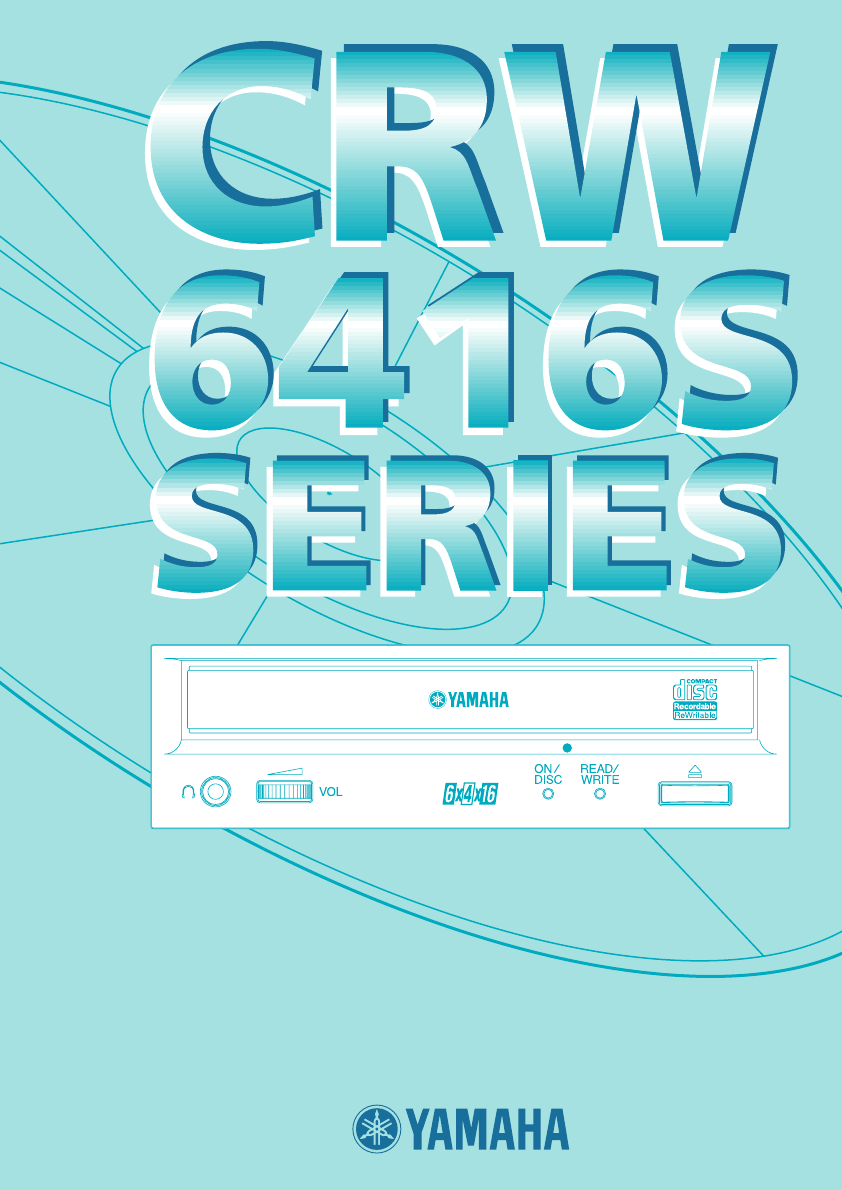
Owner’s Manual
Bedienungsanleitung
Mode d’emploi
Manual de instrucciones
2/19CRW/e.qx 2/19/99 5:46 PM Page 1
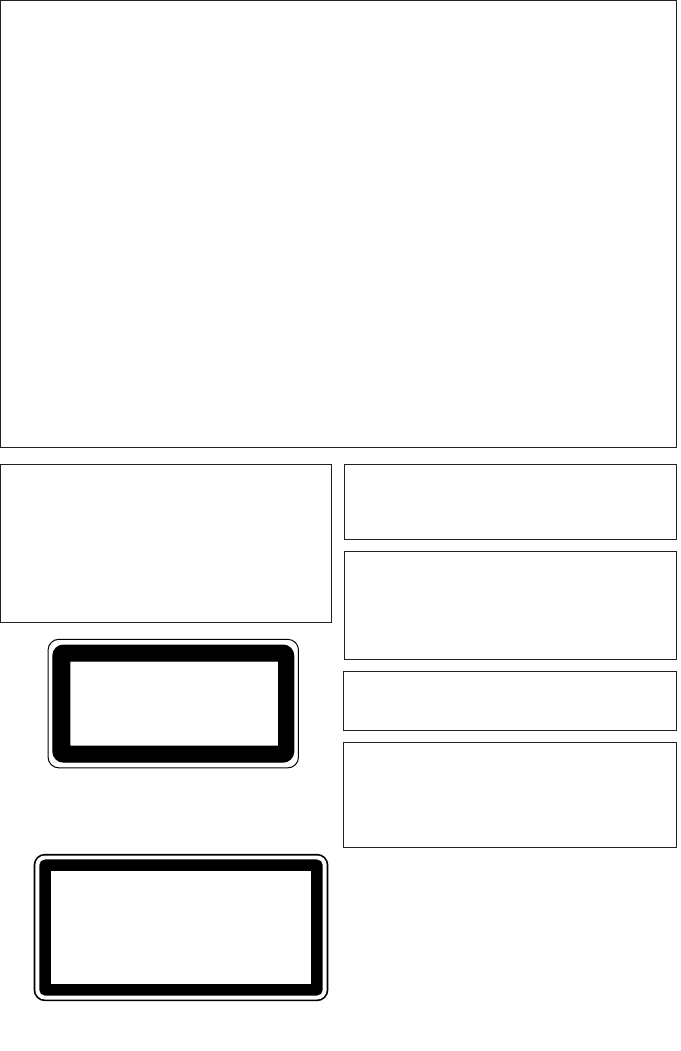
FCC INFORMATION (U.S.A.)
1. IMPORTANT NOTICE: DO NOT MODIFY THIS UNIT!
This product, when installed as indicated in the instructions contained in this manual, meets FCC requirements.
Modifications not expressly approved by Yamaha may void your authority, granted by the FCC, to use the product.
2. IMPORTANT: When connecting this product to accessories and/or another product use only high quality shielded
cables. Cable/s supplied with this product MUST be used. Follow all installation instructions. Failure to follow instructions
could void your FCC authorization to use this product in the USA.
3. NOTE: This product has been tested and found to comply with the requirements listed in FCC Regulations, Part 15 for
Class “B” digital devices. Compliance with these requirements provides a reasonable level of assurance that your use of
this product in a residential environment will not result in harmful interference with other electronic devices. This
equipment generates/uses radio frequencies and, if not installed and used according to the instructions found in the
users manual, may cause interference harmful to the operation of other electronic devices. Compliance with FCC
regulations does not guarantee that interference will not occur in all installations. If this product is found to be the source
of interference, which can be determined by turning the product “OFF” and “ON,” please try to eliminate the problem by
using one of the following measures:
Relocate either this product or the device that is being affected by the interference.
Utilize power outlets that are on different branch (circuit breaker or fuse) circuits or install AC line filter/s (only applies to
external drives).
In the case of radio or TV interference, relocate/reorient the antenna. If the antenna lead-in is 300 ohm ribbon lead,
change the lead-in to coaxial type cable.
If these corrective measures do not produce satisfactory results, please contact the local retailer authorized to distribute
this type of product. If you can not locate the appropriate retailer, please contact Yamaha Systems Technology, Inc. 100
Century Center Court, San Jose, CA95112, U.S.A.
Laser Diode Properties
Material: GaAlAs
Wavelength: 783-789 nm
Emission Duration: Continuous
Laser Output Power: Less than 44.6 µW*
* This output is value measured at a distance
200mm from the objective lens surface on the
optical pick-up block.
ANSI Class : Class 1
CAUTION
Use of controls or adjustments or performance of
procedures other than those specified herein may result
in hazardous radiation exposure.
This device is classified as a CLASS 1
LASER product.
The CLASS 1 LASER PRODUCT
label must be located on the exterior.
CAUTION : INVISIBLE LASER RADIATION WHEN OPEN. AVOID EXPOSURE TO BEAM.
VORSICHT : UNSICHTBARE LASERSTRAHLUNG WENN ABDECKUNG GEOFFNET.
NICHT DEM STRAHL AUSSETZEN.
VARNING : OSYNLIG LASERSTRÅLNING NÄR DENNA DEL ÄR ÖPPNAD OCH
SPÄRREN ÄR URKOPPLAD. BETRAKTA EJ STRÅLEN. STRÅLEN ÄR FARLIG.
VARO! : AVATAESSA JA SUOJALUKITUS OHITETTAESSA OLET ALTTINA
NÄKYMÄTTÖMÄLLE LASERSÄTEILYLLE. ÄLÄ KATSO SÄTEESEEN.
ADVARSEL: USYNLIG LASERSTRALNING VED ÅBNING NÅR SIKKERHETSAF-
BRYDERE ER UDE AF FUNKTION. UNDGÅ UDSETTELSE FOR STRÅLNING,
This manual applies to the CRW6416S and CRW6416S-NB.
The CRW6416S front panel displays the YAMAHA brand name.
The CRW6416S-NB front panel does not display a brand name.
CLASS 1 LASER PRODUCT
LASER KLASSE 1 PRODUKT
LUOKAN 1 LASERLAITE
PRODUIT LASER DE CLASSE 1
ADVARSEL
USYNLIG LASERSTRÅLING VED ÅBNING.
UNDGÅ UDSAETTELSE FOR STRÅLING.
VAROITUS
LAITTEEN KÄYTTÄMINEN MUULLA KUIN TÄSSÄ
KÄYTTÖOHJEESA MAINITULLA TAVALLA SAATTAA
ALTISTAA KÄYTTÄJÄN TURVALLISUUSLUOKAN 1
YLITTÄVÄLLE NÄKYMÄTTÖMÄLLE
LASERSÄTEILYLLE.
VARNING
OM APPARATEN ANVÄNDS PÅ ANNAT SÄTT ÄN I
DENNABRUKSANVISNING SPECIFICERATS, KAN
ANVÄNDAREN UTSÄTTAS FÖR OSYNLIG
LASERSTRÅLNING, SOM ÖVERSKRIDER GRÄNSEN
FÖR LASERKLASS 1.
Warning instruction for laser radiation.
Varningsanvisning för laserstrålning.
2/19CRW/e.qx 2/19/99 5:46 PM Page 2
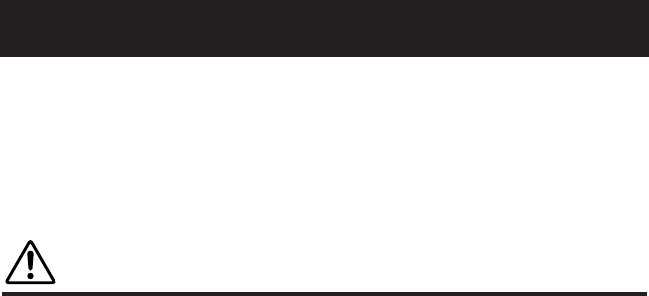
SAFETY PRECAUTIONS
PLEASE READ CAREFULLY BEFORE PROCEEDING
These precautions explain how to use the device correctly and safely, thereby preventing injury to
yourself or to others. This section has been sub-divided into a WARNING section and a CAUTION
section, according to the likelihood and nature of any potential injuries or damage inflicted. They
relate to your personal safety, and also help you minimize the risk of damaging the device. Please
read these sections carefully before proceeding.
WARNING
Always follow the basic precautions listed below to avoid the possibility of serious injury or
even death from electrical shock, short-circuiting, damages, fire or other hazards. These
precautions include, but are not limited to, the following:
●Do not open the device or attempt to disassemble or modify it.
Otherwise, there is an increased risk of electrical shock or fire. The device contains no user-
serviceable parts. If it appears to be malfunctioning, have it inspected by qualified service personnel.
●Do not look inside the device.
If you expose your eyes to the laser inside the device, you risk losing your vision.
●Do not insert fingers or foreign objects into the device.
Otherwise, there is an increased risk of personal injury, electrical shock, damage to the device or fire.
Please take particular care if small children are present.
●Do not expose the device to rain, use it near water or in damp or wet conditions or place
containers on it containing liquids which might spill into any openings.
Otherwise, there is an increased risk of electrical shock, fire or personal injury.
●Follow the Owner’s Manual carefully.
Otherwise, there is an increased risk of personal injury, electrical shock, fire or damage to the unit.
Follow the correct procedure when setting up the device.
●If unusual smells, sounds or smoke emanate from the device or if liquids enter the device, switch
the computer off immediately and unplug it from the power outlet.
Otherwise, there is an increased risk of electrical shock, fire or damage to the device. Return the
device immediately to the store at which it was purchased or alternatively, to the nearest Yamaha
Service Center (listed at the back of this manual).
●Make sure the computer is electrically grounded
Otherwise, there is an increased risk of electrical shock.
●When opening up the computer, always unplug the computer from the electrical outlet. Do not
touch the plug with wet hands.
Otherwise, there is an increased risk of electrical shock.
● When used in a fan-cooled system, the drive should not be exposed to temperatures outside the
range 5°C ~ 40°C (41°F ~ 104°F).
2/19CRW/e.qx 2/19/99 5:46 PM Page 3

CAUTION
Always follow the basic precautions listed below to avoid the possibility of physical injury to
you or others, or damage to the instrument or other property. These precautions include, but are
not limited to, the following:
●Always unplug the computer from the electrical outlet if it will not be used for a prolonged period
of time or if there is a risk of lightning.
Otherwise, there is an increased risk of electrical shock, short-circuiting or fire.
●Do not expose the device to excessive heat or vibrations or extreme cold or heat (such as in direct
sunlight or near a heater).
Otherwise, the front panel of the may become disfigured or the internal components may be
damaged.
●Do not use the device near other electrical products such as televisions, radios or speakers.
Otherwise, this may cause interference which can affect the proper operation of those other products.
●Do not place the device in an unstable position.
Otherwise, it may accidentally fall down and be damaged or cause personal injury.
●Mount the device horizontally.
Otherwise, written data may be destroyed. Set the device up according to the instructions in the
Owner’s Manual.
●Always remove the disc from the tray before transporting the device.
Otherwise, written data may be destroyed.
●When cleaning the device, never use benzene, paint thinners, detergents, or chemical-impregnated
wiping cloths. Also, do not place vinyl, plastic or rubber objects on the device.
Otherwise, the device may be damaged or its front panel may become discolored. Use a soft, dry
cloth to wipe the device.
●Do not rest your weight on or place heavy objects on the device and do not use excessive force on
the buttons, switches or connectors.
Otherwise, there is an increased risk of damage to the device or personal injury.
●Do not listen to audio with headphones at high volume and for prolonged periods of time.
Otherwise, there is an increased risk of hearing loss.
l Before using the device, set the volume dial to its lowest setting.
Otherwise, sudden bursts of sound can cause hearing loss.
●Do not place the device near sources of magnetic interference, such as computer displays.
Magnetic interference can affect the operation and stability of the device.
●Have the device serviced regularly.
Otherwise, dust can build up inside the device, increasing the risk of fire or damage. For information
about servicing charges, contact the store at which the device was purchased or alternatively, the
nearest Yamaha Service Center (listed at the back of this manual). The device should be serviced
about once a year.
2/19CRW/e.qx 2/19/99 5:46 PM Page 4

■About CD-R/RW discs
Please read the following regarding the handling of CD-R/RW discs.
1. Do not expose discs to excessive heat or vibrations or extreme cold or heat (such as in
direct sunlight or near a heater).
2. Do not touch disc surfaces.
When handling a disc, hold it by its edges.
3. Remove dust and dirt from disc surfaces.
Use air-based dust removers. The surfaces may be scratched if wiped with a dry cloth.
4. Do not write or stick labels on disc surfaces except where indicated.
5. Do not clean discs with chemicals or detergents.
6. Do not bend or drop discs.
1. The information contained in this manual is subject to
change without prior notice.
2. All trademarks contained in this manual belong to their
respective owners.
3. Yamaha does not bear any responsibility for any outcome
as a result of using this device.
4. Reproduction of this manual, either in part or in full, is
expressly forbidden.
nElectrical plugs/sockets vary according to country/region.
5
2/19CRW/e.qx 2/19/99 5:46 PM Page 5

6
©1999 Yamaha Corporation. All Rights Reserved.
This document may not, in whole or in part, be copied, photocopied,
reproduced, translated, transmitted or reduced to any electronic medium of
machine readable form without prior consent in writing from Yamaha.
MS-DOS and Windows are registered trademarks of Microsoft Corporation.
Unix is a registered trademark of UNIX System Laboratories.
All other trademarks are the property of their respective companies.
Table of Contents
Setup Flowchart ..........................................................................................................................7
Introduction ..................................................................................................................................8
Features of the CRW6416S Drive ....................................................8
System Configuration..............................................................................................................9
Computer ........................................................................................9
Software............................................................................................9
Media..............................................................................................10
Tools ..............................................................................................11
Front and Rear of Unit ............................................................................................................12
Front Panel ....................................................................................12
Rear Panel ......................................................................................13
Installation ..................................................................................................................................14
First Steps ......................................................................................14
Installing the CRW6416S Drive ....................................................19
Fitting the CRW6416S as an Additional Drive ......................20
Replacing an Existing CD-ROM Drive with the CRW6416S ......28
Operation ......................................................................................................................................37
Troubleshooting ......................................................................................................................39
Appendix ......................................................................................................................................42
Writing Modes................................................................................42
About the firmware........................................................................44
LED Indicator Messages ................................................................44
CRW6416S Specifications ..............................................................45
Index................................................................................................................................................47
Distributors and Head Offices ..........................................................................................48
2/19CRW/e.qx 2/19/99 5:46 PM Page 6
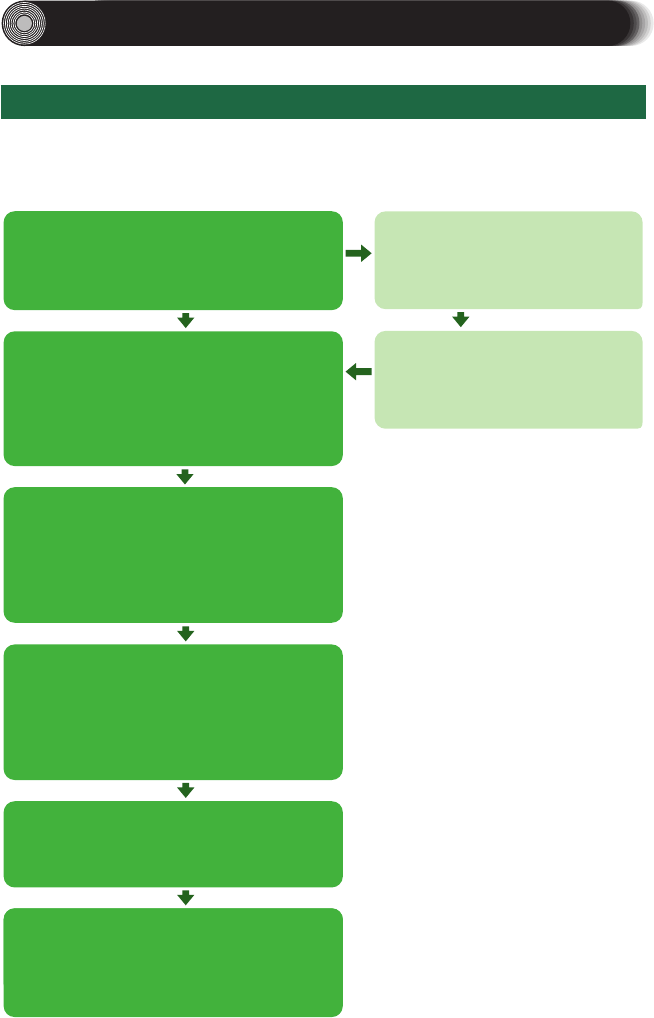
7
Setup Flowchart
CRW6416S Setup Flowchart
This flowchart shows the procedure for setting up the CRW6416S drive. For
easy cross-referencing, the relevant pages in this manual are also given.
STEP
1STEP
1-1
STEP
1-2
STEP
2
STEP
3
STEP
4
STEP
5
STEP
6
YES
NO
Do you have a SCSI adapter
card?
Check that the SCSI adapter
card is installed correctly
Set up the CRW6416S drive
Install the CD writing software
Check that the CRW6416S
drive is installed correctly
Obtain a SCSI adapter card
Install the SCSI adapter card
Recommended models:
Adaptec AHA2940AU-series (PCI)
Read this manual and insert the
SCSI card into the appropriate
PCI slot on the computer.
Go to Control Panel | System | Device
Manager tab. Double-click on SCSI
controllers and check that the adapter
card has been installed correctly.
Go to Control Panel | System | Device
Manager tab. Double-click on CDROM
and check that the drive has been
installed correctly.
For details about how to install the
software, refer to the manual that comes
with it.
Start using the CRW6416S
drive!
Use the drive to create audio CDs, to
back up data on your hard disk, or for
whatever purpose suits your needs.
1. Set the jumper switches (P.16)
2. Fit the drive into the computer
● Tower-type case (P.20)
As additional or replacement drive
● Desktop-type case (P.28)
As a replacement drive
2/19CRW/e.qx 2/19/99 5:46 PM Page 7
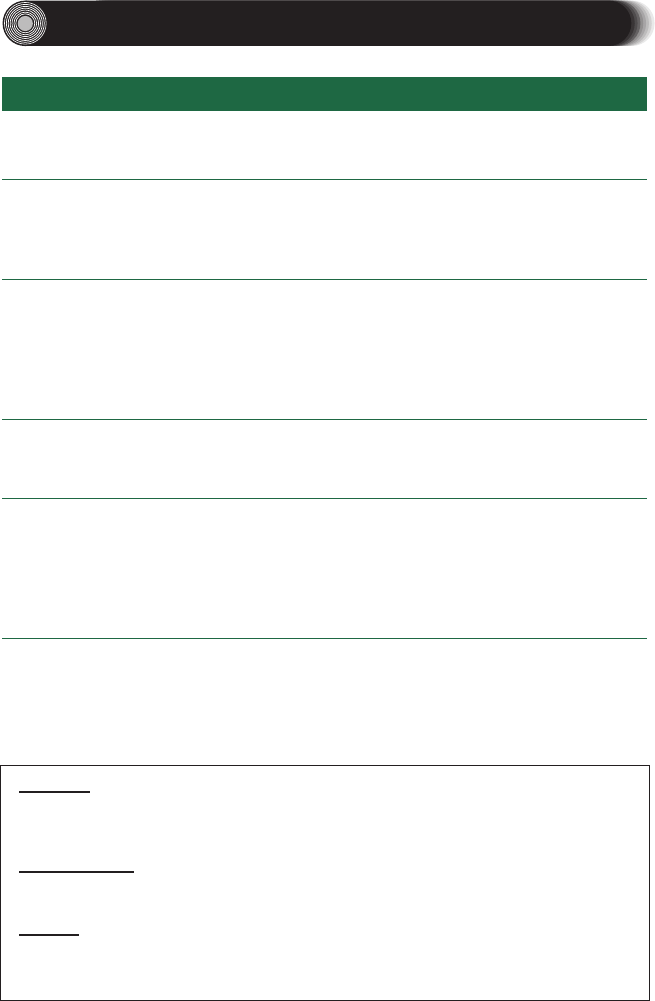
8
Introduction
Features of the CRW6416S Drive
6X Speed Writing to CD-R, 4X Speed Writing to CD-RW and 16X Speed
Reading
The CRW6416S drive can write to CD-R at 6X, 4X or 1X (normal) speed and
write/overwrite to CD-RW at 4X or 2X speed. It can also read from CD-R and CD-
ROM media at up to 16X speed.
Supports a Wide Range of CD Formats
The CRW6416S drive can read from and write to CD-ROM in standard ISO9660
format and to audio CD in CD-DA format. Use the drive for a wide variety of
purposes, such as backing up data, writing your own audio CDs and creating
multimedia titles (using CD Extra mode). Just choose the writing/reading format
that suits your needs. For more details, refer to page 10.
Fast SCSI-2 Compatible
The CRW6416S is compatible with Fast SCSI-2, the second-generation SCSI protocol
for interconnecting computers and peripherals.
Windows 95/98 Plug and Play Compatible
Under Windows 95 or Windows 98, the SCSI ID number of the CRW6416S can be
set automatically since the drive supports the SCAM Level 1 protocol. If there is a
conflict between the manually-assigned SCSI ID of the CRW6416S drive and the ID
of another SCSI device on the same chain, the CRW6416S is automatically assigned a
vacant SCSI ID instead.
Supports all Four CD Writing Modes
These modes are Disc-at-Once (the disc is written in a single pass without pausing),
Track-at-Once (data can be written incrementally to disc one track at a time),
Session-at-Once (each session is written in a single pass without pausing), and
Packet Writing (data can be written to disc in small increments just like with a
floppy or hard disk). For more details, refer to page 42.
Copyrights
When writing to CD-R/RW, make sure that you are not breaching any copyrights. It is illegal to
copy audio CDs for non-personal use. When backing up software, please make sure that you are
not breaching any software copyrights for that product.
Distributing discs
When writing important data or preparing data for distribution to others, make sure that the disc
can be read properly before writing duplicates.
Warranty
Yamaha accepts no liability for the loss of any data or any problems caused as a result. As a
precaution, it is recommended that the discs are tested after they have been written to.
Furthermore, under no circumstances does Yamaha guarantee the reliability of the media.
2/19CRW/e.qx 2/19/99 5:46 PM Page 8
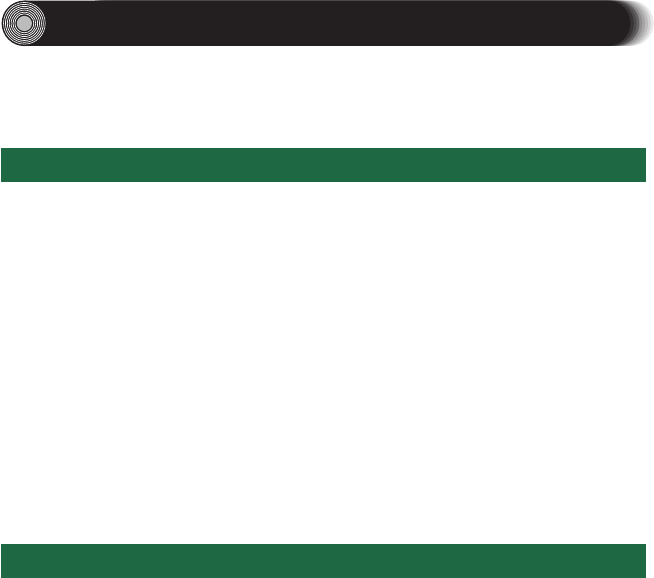
9
System Configuration
In order to use the CRW6416S drive, your computer system will need to meet
the following set of requirements.
Computer
The minimum hardware requirements for using the CRW6416S drive are as
follows:
●Any fully PC/AT-compatible computer.
●A Pentium-class or higher CPU running at 133MHz or faster. (200MHz or
faster recommended.)
●A 5.25-inch drive bay for mounting the drive.
●A spare expansion slot for a SCSI card (if one hasn’t been installed yet).
●A SCSI card to connect SCSI devices (including the CRW6416S) to your
computer. Make sure it has an internal bus connector. Yamaha recommends
any of Adaptec’s AHA2940AU-series cards (PCI slot).
Software
The software requirements for using the CRW6416S drive are as follows:
●OS: Windows 95, Windows 98, or Windows NT4.0 with Service Pack 3.
●CD writing software. This software must support the CRW6416S drive for
writing to CD-R or CD-RW.
nFor details about how to install and use the software, refer to the manual that comes with it.
●Sufficient free hard disk space to install the necessary software. You will
need a further 750MB of free space, or 800 ~ 850MB for packet writing, if
you plan to write an image file to hard disk prior to writing to CD-R or CD-
RW.
nData is written to disc much more reliably when writing from an image file, eliminating the
likelihood of errors occurring. Furthermore, this solution is ideal when making multiple
copies of discs since the original data is backed up to hard disk as an image file.
2/19CRW/e.qx 2/19/99 5:46 PM Page 9
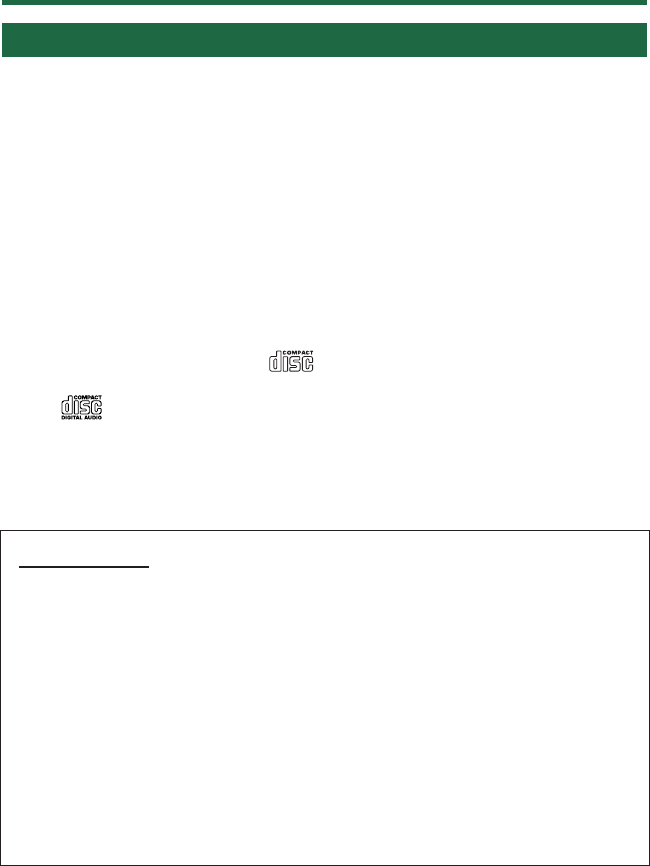
Media
The CRW6416S drive is compatible with discs which meet the following
specifications:
●CD-R discs:
Use discs that conform to the Orange Book Part 2 standards. When writing
to CD-R at 4X or 6X speed, you should use discs that have been designed for
high-speed recording.
●CD-RW discs:
Use discs that conform to the Orange Book Part 3 standards. When writing
to CD-RW at 4X speed, you should use discs that have been designed for
high-speed recording.
●Read-only discs:
You can read from any CD-ROM discs that conform to the Yellow Book
standard, and which bear the logo. You can also play back any CD-
DA (audio) discs that conform to the Red Book standards, and which bear
the logo.
nThe Orange Book standard defines how all recordable discs (including CD-R and CD-RW) are
written. Part 2 of the Orange Book standard relates to CD-R discs and Part 3, to CD-RW discs.
The standard was named after the color of the book’s pages. Similarly, the Red Book standard
relates to audio (CD-DA) discs and the Yellow Book standard relates to CD-ROM discs.
About CD-ROM
A CD-ROM disc is a compact disc containing high-density read-only data. It
has many applications, including the playback of music and video, the
archiving of data, as well as on-line documentation. The following are
descriptions of each CD-ROM format:
CD-DA: Up to 74 minutes of audio is written in 16-bit resolution at a
sampling rate of 44.1kHz.
CD Extra: Audio, text, video and so on are written as a multisession disc.
Applications are wide and varied, including computer games and on-line
publishing.
Video CD: Up to 74 minutes of video and audio is compressed in MPEG
format for playback.
10
System Configuration
2/19CRW/e.qx 2/19/99 5:46 PM Page 10
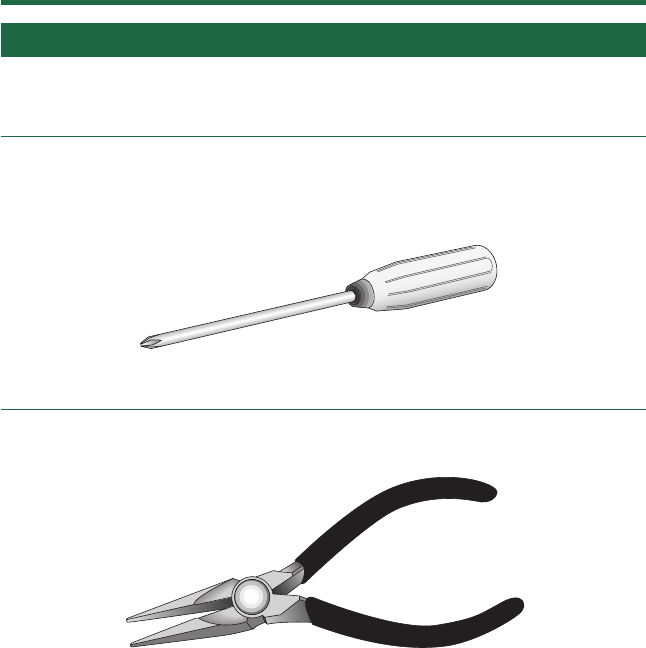
11
Tools
You will need the following tools at hand when installing the CRW6416S drive.
Philips Screwdriver
You will need to use this when removing the cover of your computer and when
mounting the drive. You may also need to temporarily remove the sound card to
gain access to the CD audio connectors. In which case a small screw retaining
the sound card’s face plate has to be removed.
Long-Nosed Pliers
You will need these to insert or remove the plastic jumper shunts when setting
the jumper switches at the back of the CRW6416S drive.
System Configuration
2/19CRW/e.qx 2/19/99 5:46 PM Page 11
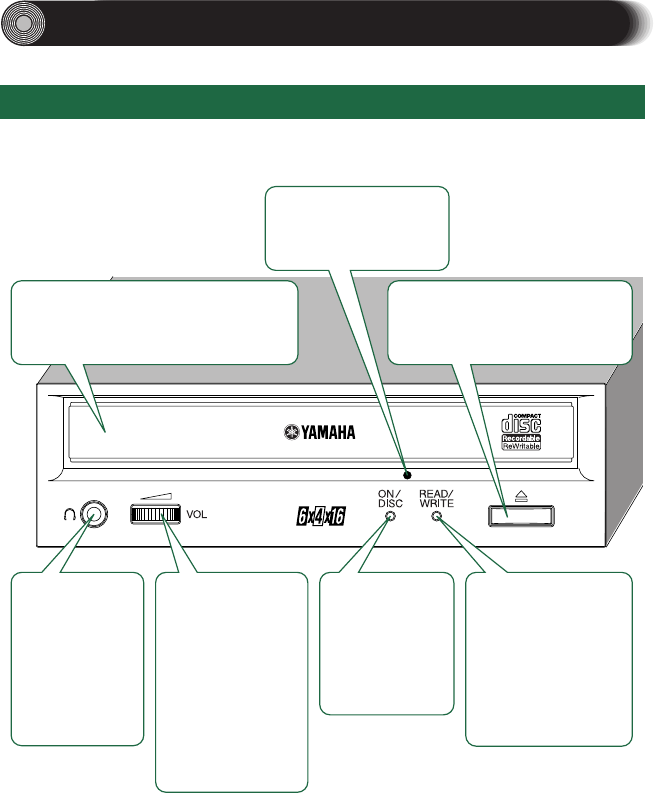
12
Front and Rear of Unit
Front Panel
The CRW6416S drive’s front panel features the following:
Disc tray
The tray is used to hold the disc.
It slides out from the drive unit when
a disc needs to be loaded or unloaded.
Eject button
Press this button when you need
to unload a disc. Remove the
disc after the tray has opened.
Manual eject hole
Only use this if no other
method is available for
unloading a disc.
Headphone
jack
You can
connect stereo
headphones to
this stereo mini
jack and listen
to audio CDs
loaded in the
drive.
Headphone
volume control
Adjust this control
to set a suitable
volume level when
listening to an
audio CD using
the headphone
jack. Slide the
knob to the left to
decrease the
volume and to the
right to increase it.
ON/DISC LED
This LED is
orange when
the drive is
powered on,
and green when
the drive
contains a disc.
READ/WRITE LED
This LED is green
when data is being
read off a disc, and
orange when data is
being written. It
flashes on and off
intermittently when
the disc is being
accessed.
2/19CRW/e.qx 2/19/99 5:46 PM Page 12
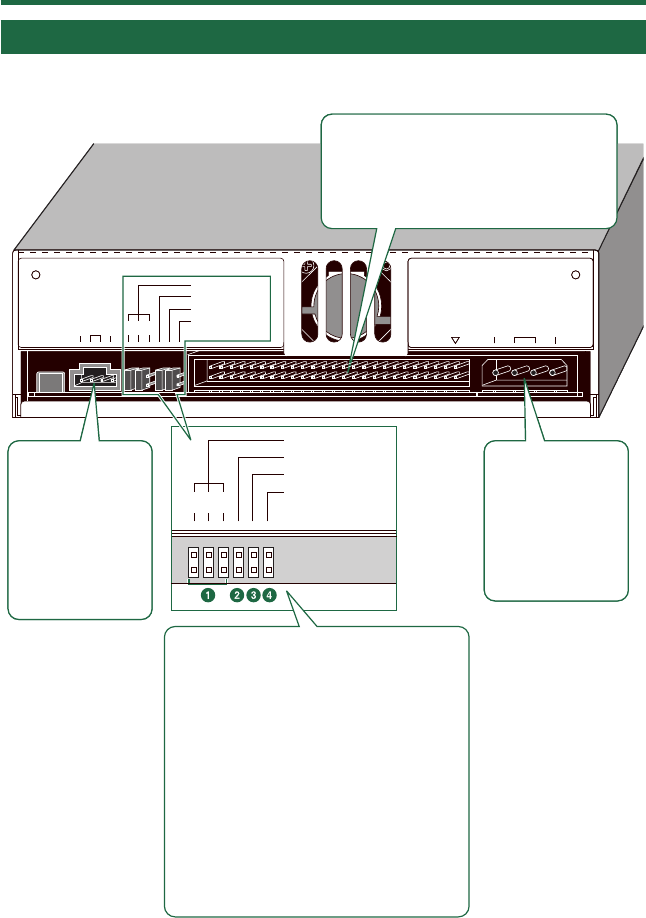
Rear Panel
The CRW6416S drive’s rear panel features the following:
AUDIO OUT
ID SELECT
PARITY
TERMINATOR
BLOCK SIZE
SCSI
INTERFACE
CONNECTOR DC INPUT
1+5V G +12V
R L 1 2 4G
AUDIO OUT
connector
Connect one end
of the supplied 4-
pin audio cable
to this and the
other end to your
computer’s sound
card or built-in
audio.
DC INPUT
connector
Insert the power
connector from
your computer’s
power supply in
this socket to
feed power to the
drive.
SCSI connector
Insert the connector of the SCSI ribbon
cable here. Make sure you align the
red line of the ribbon cable with pin 1 of
the drive’s connector, marked “SCSI
INTERFACE CONNECTOR 1.”
ID SELECT
PARITY
TERMINATOR
BLOCK SIZE
1 2 4
1 ID SELECT jumper switches
Set these switches using black plastic
shunts in order to manually assign a SCSI
ID number for the drive.
2 PARITY jumper switch
Set this switch using a black plastic shunt
in order to enable parity checking.
3 TERMINATOR jumper switch
Set this switch using a black plastic shunt
in order to enable the drive’s built-in SCSI
termination.
4 BLOCK SIZE jumper switch
Set this switch using a black plastic shunt
in order to set the block size to 512 bytes
per sector.
AUDIO OUT
SCSI
INTERFACE
CONNECTOR DC INPUT
1+5V G +12V
R LG
ID SELECT
PARITY
TERMINATOR
BLOCK SIZE
1 2 4
AUDIO OUT
connector
Connect one end
of the supplied
4-pin audio cable
to this and the
other end to your
computer’s sound
card or built-in
audio.
DC INPUT
connector
Insert the power
connector from
your computer’s
power supply in
this socket to
feed power to the
drive.
SCSI connector
Insert the connector of the SCSI ribbon
cable here. Make sure you align the
red line of the ribbon cable with pin 1 of
the drive’s connector, marked “SCSI
INTERFACE CONNECTOR 1.”
13
Front and Rear of Unit
2/19CRW/e.qx 2/19/99 5:46 PM Page 13
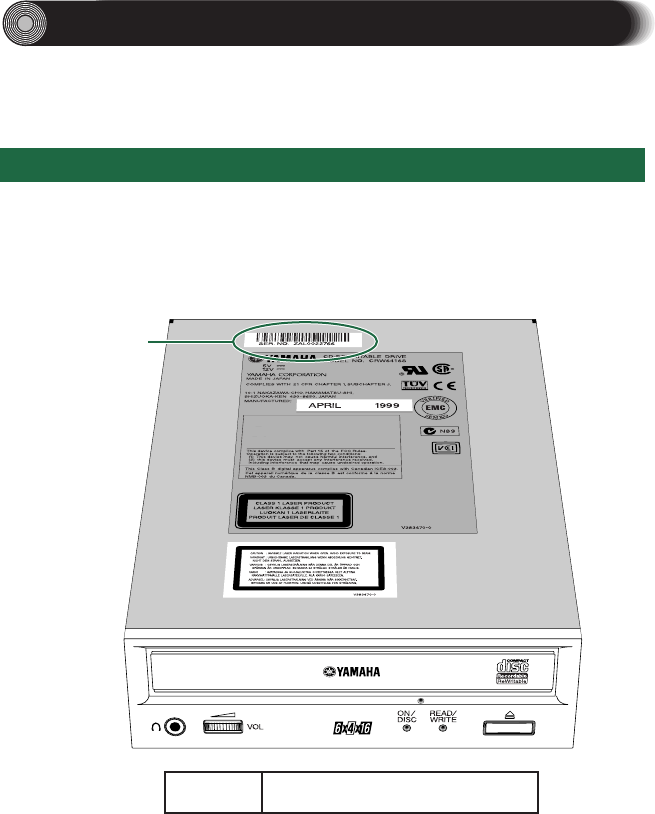
Installation
This section gives a step-by-step guide to installing the CRW6416S drive. Make
sure you have all the necessary tools.
First Steps
Once you have taken the CRW6416S drive out of its packaging, you should
immediately note down the serial number shown on the top of the drive
together with a barcode. There is a box below the following diagram in which
you can write down the serial number.
Before fitting the CRW6416S drive into the computer, you need to set up the
drive using the jumper switches located at the rear of the unit. You’ll need to set
the following:
●SCSI ID number
●Parity check
●Termination
●Block size
Drive’s serial
number
Serial No.
14
2/19CRW/e.qx 2/19/99 5:46 PM Page 14
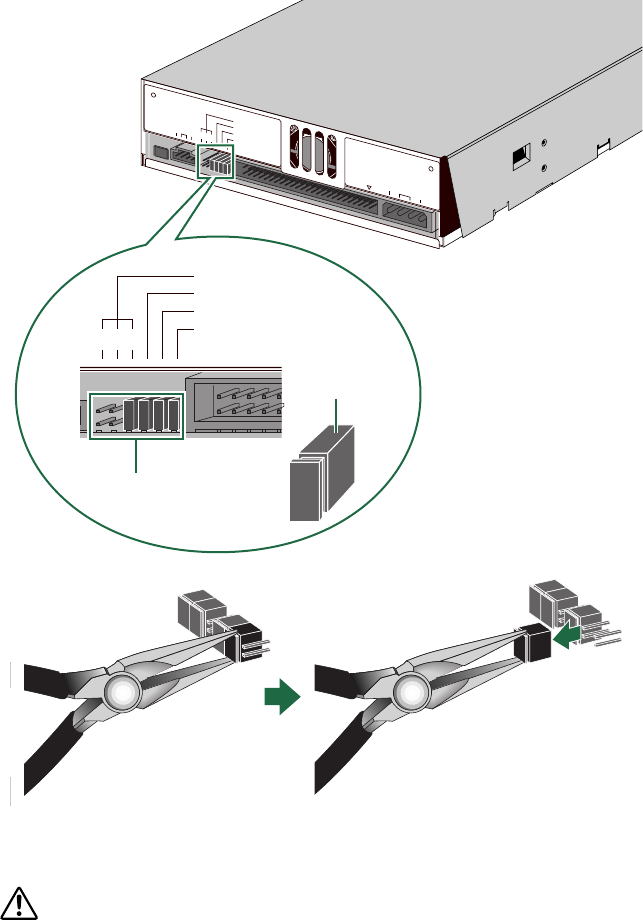
To set each jumper switch, you have to bridge the two pins in the respective
column of the grid with a plastic shunt. Shunts are already attached to the
jumper switches in their default configurations.
nThe plastic shunts actually contain metal for bridging the two pins of a jumper switch, creating
an electrical connection between them when attached. When removed, the jumper switch is
set to “off.” Store unused shunts in a safe place where they will not be lost.
Use a pair of long-nosed pliers to attach or detach the shunts accordingly.
However, make sure that the computer is switched off when doing so.
AUDIO OUT
ID SELECT
PARITY
TERMINATOR
BLOCK SIZE
SCSI
INTERFACE
CONNECTOR DC INPUT
1+5V G +12V
R L 1 2 4G
ID SELECT
PARITY
TERMINATOR
BLOCK SIZE
1 2 4
Rear Panel
Jumper switches
Shunt
15
2/19CRW/e.qx 2/19/99 5:46 PM Page 15
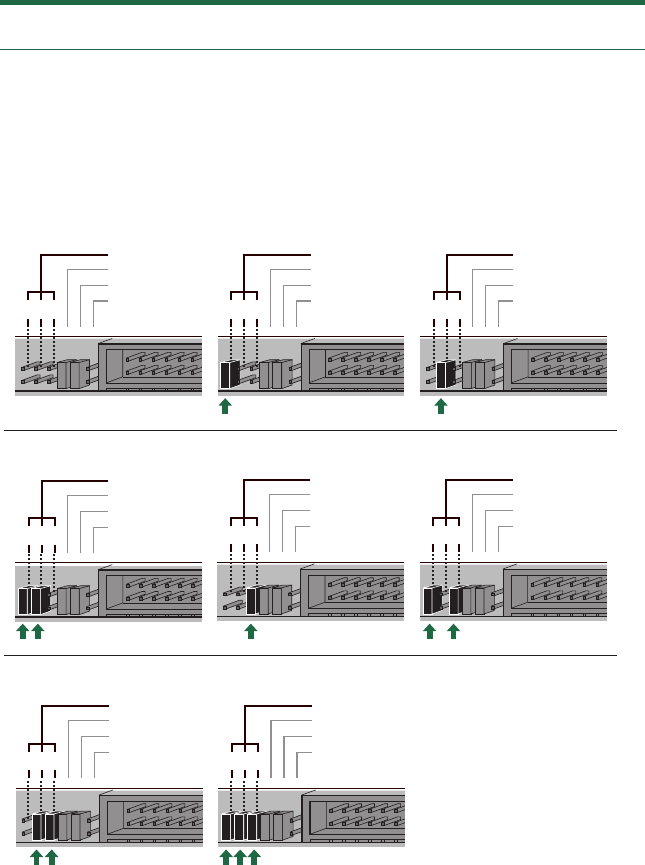
1SCSI ID number
Each of the SCSI devices connected to the computer is identified by its SCSI ID
number. You need to assign a number from “0” to “7” for each SCSI device.
Commonly, ID number “7” is reserved for the computer’s SCSI adapter card
itself. Therefore, the CRW6416S can actually be assigned an ID number from
“0” to “6.” If it’s the first device in the chain, you should assign it ID number
“0.” The ID number is set by attaching/detaching the shunts on the ID Select
jumper switches according to the diagram shown below.
nThe SCSI ID number for each device on the chain must be unique. Make sure the CRW6416S
drive’s SCSI ID number is not the same as that of any other device on the chain. By factory
default, the CRW6416S is assigned ID number “3” but this can be changed.
nThe CRW6416S is compliant with the SCAM Level 1 protocol. This means that if there is a
conflict between the manually-assigned SCSI ID of the drive and the ID of another SCSI device
on the same chain, the CRW6416S is automatically assigned an alternative vacant SCSI ID by
the Plug and Play component of Windows 95 or Windows 98.
ID SELECT
PARITY
TERMINATO
R
BLOCK SIZE
1 2 4
ID SELECT
PARITY
TERMINATO
R
BLOCK SIZE
1 2 4
ID SELECT
PARITY
TERMINATO
R
BLOCK SIZE
1 2 4
ID SELECT
PARITY
TERMINATOR
BLOCK SIZE
ID SELECT
PARITY
TERMINATOR
BLOCK SIZE
ID SELECT
PARITY
TERMINATOR
BLOCK SIZE
1 2 4 1 2 4 1 2 4
ID SELECT
PARITY
TERMINATO
R
BLOCK SIZE
1 2 4
ID SELECT
PARITY
TERMINATO
R
BLOCK SIZE
1 2 4
SCSI ID 0 SCSI ID 1 SCSI ID 2
SCSI ID 3 (Default) SCSI ID 4 SCSI ID 5
SCSI ID 6 SCSI ID 7
16
Installation
2/19CRW/e.qx 2/19/99 5:46 PM Page 16
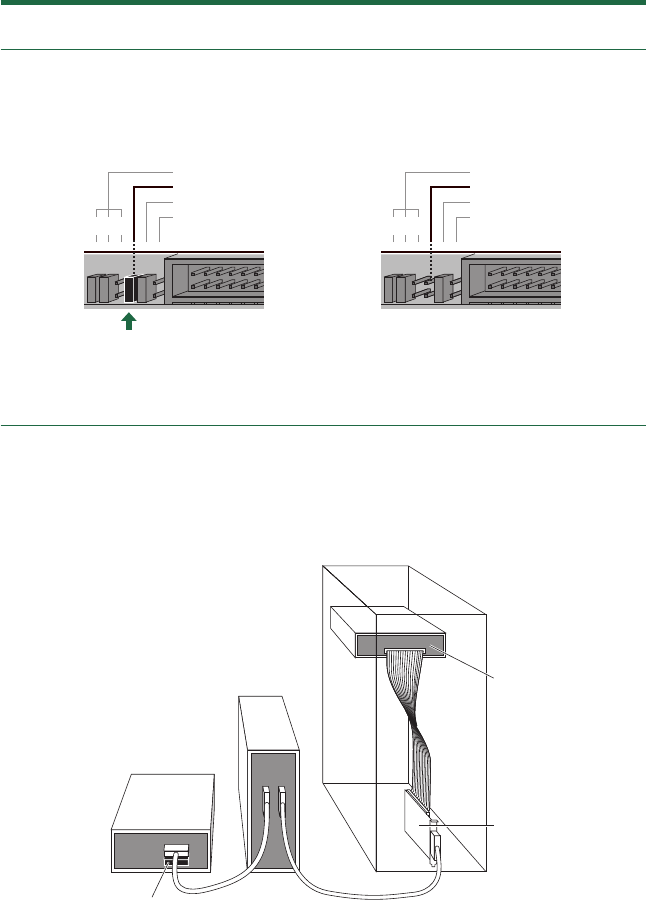
2Parity Check
The parity check is used for error correction during data transmissions. If
parity-checking has to be disabled, the shunt on the Parity jumper switch should
be removed.
nBy factory default, the Parity switch is set to “on” and should normally be left in this state.
3Termination
Terminators prevent SCSI signals from being reflected off the last device in the
chain. The SCSI terminator switch should be set to “on” if the CRW6416S is the
last device on the internal SCSI chain. If the CRW6416S is not the last device on
the internal SCSI chain, the shunt on the Terminator jumper switch should be
removed.
nBy factory default, the Terminator switch is set to “on.”
Computer
CRW6416S
(unterminated)
Daisy chain
Hard disk
drive
MO drive
(terminated)
Terminator
SCSI adapter
card
ID SELECT
PARITY
TERMINATOR
BLOCK SIZE
1 2 4
ID SELECT
PARITY
TERMINATOR
BLOCK SIZE
1 2 4
Parity on
(Default)
Parity off
17
Installation
2/19CRW/e.qx 2/19/99 5:46 PM Page 17
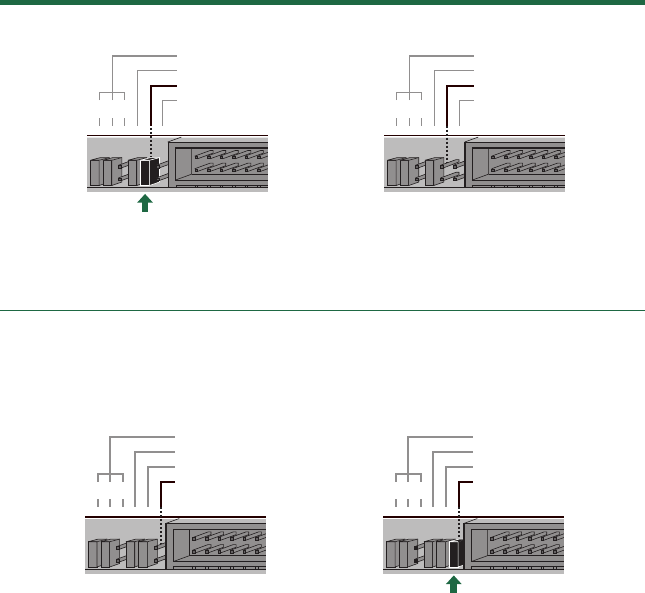
4Block Size
The data block size of the CRW6416S can be set to 512 bytes per sector by
setting the Block Size jumper switch to “on.” This is necessary when installing
the CRW6416S on a UNIX-based workstation.
nBy factory default, the Block Size jumper switch is set to “off” and should normally be left in
this state.
ID SELECT
PARITY
TERMINATOR
BLOCK SIZE
1 2 4
Block size off (Default)
ID SELECT
PARITY
TERMINATOR
BLOCK SIZE
1 2 4
Block size on
Set to “on” when installing
CRW6416S drive on UNIX
workstation
ID SELECT
PARITY
TERMINATOR
BLOCK SIZE
1 2 4
ID SELECT
PARITY
TERMINATOR
BLOCK SIZE
1 2 4
Termination on (Default) Termination off
Set to “on” if CRW6416S drive
is last device on SCSI chain
18
Installation
2/19CRW/e.qx 2/19/99 5:46 PM Page 18
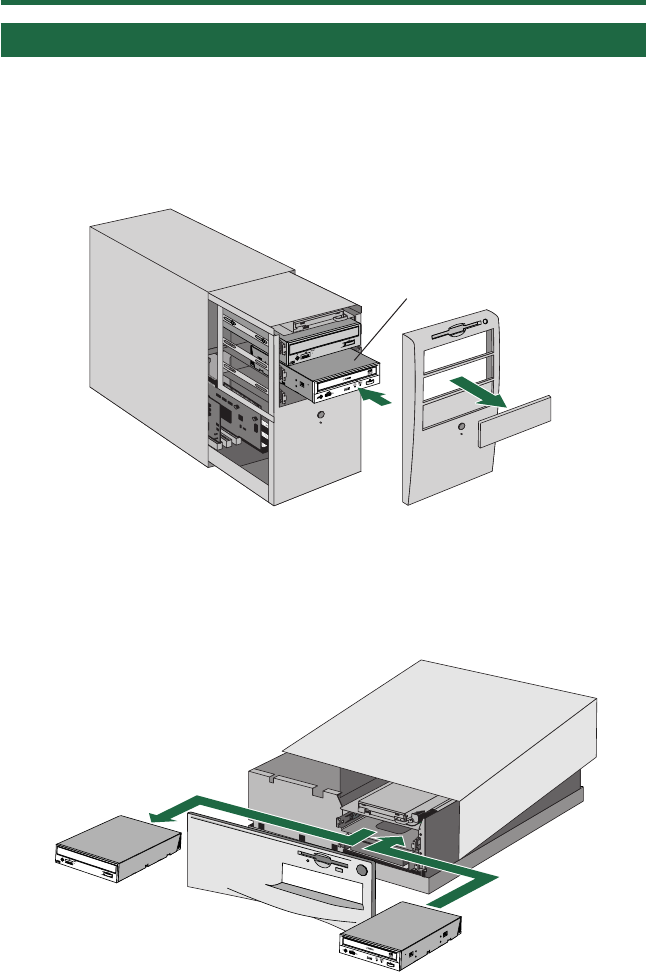
Installing the CRW6416S Drive
You can install the CRW6416S drive in one of two possible ways:
●As an additional drive
If the casing of your computer has a spare 5.25-inch drive bay available, such as
with many tower-type designs, you can fit the CRW6416S drive in addition to
the computer’s existing CD-ROM drive.
●As a replacement drive
If the casing of your computer does not have a spare 5.25-inch drive bay
available, such as with many desktop-type designs, you can replace the
computer’s existing CD-ROM drive with the CRW6416S drive.
CRW6416S
CD-ROM drive
CRW6416S
19
Installation
2/19CRW/e.qx 2/19/99 5:46 PM Page 19

Fitting the CRW6416S as an Additional Drive
1Power down your computer and unplug it from the AC outlet.
If you proceed without doing this, you run the risk of receiving an
electric shock and/or short-circuiting and damaging components
including the CRW6416S drive.
2Remove the outer casing of the computer. If you need to remove screws in
the process, make sure you don’t lose them.
nThe method for removing the casing and fitting the drive in the drive bay can vary depending
on the manufacturer. Refer to the documentation that came with your computer for further
details.
20
Installation
2/19CRW/e.qx 2/19/99 5:46 PM Page 20
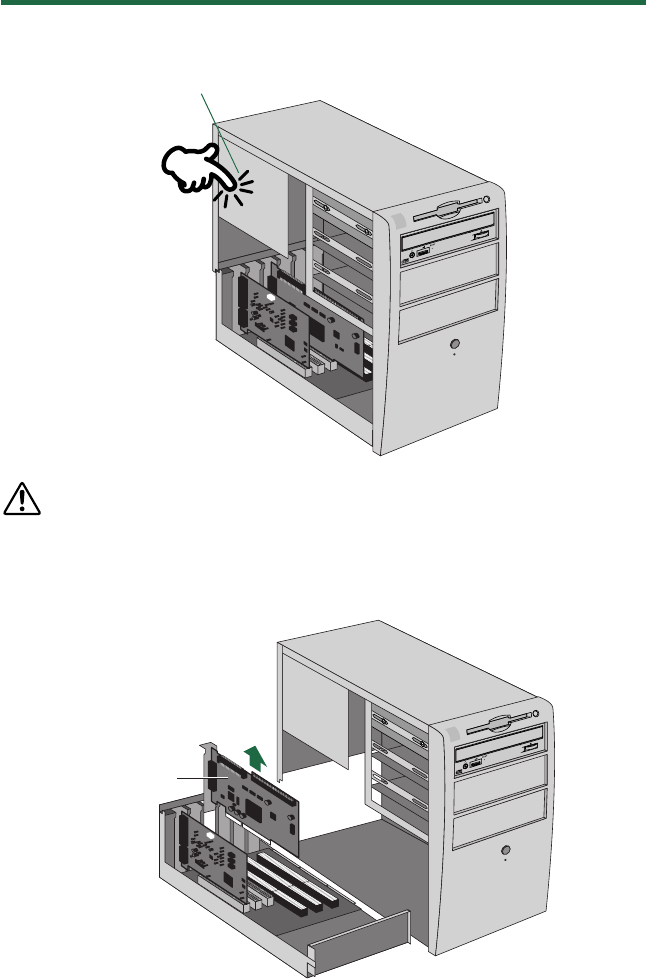
3Touch a metal part of the computer’s chassis or power supply unit to drain
any static charge that may have built up inside your body.
You can permanently damage equipment if you touch it while there is
any static charge in your body.
4Remove the SCSI adapter card from the computer and turn its termination
OFF so that internal SCSI devices may be connected. Refer to the
documentation that came with your SCSI adapter card for further details.
nSome SCSI adapter cards are capable of auto-termination. If your card is of this type, you will
not need to remove it from its slot since you will not need to set any of its switches or
jumpers.
SCSI adapter card
Drain any static charge
21
Installation
2/19CRW/e.qx 2/19/99 5:46 PM Page 21
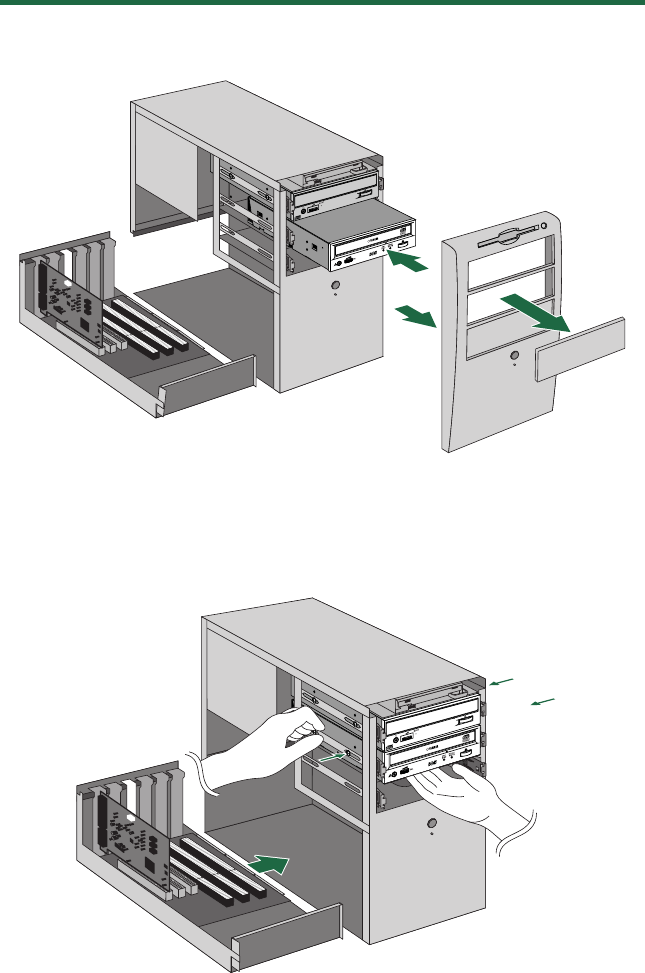
5Remove the front cover of a vacant 5.25-inch drive bay slot in the computer
and slide the drive backwards into the slot.
nDo not apply excessive force when sliding the drive back into the drive bay slot.
6Leave enough room behind the drive for connecting the power, SCSI and
audio cables. Then tighten the included four fastening screws on the sides of
the unit by hand to hold the drive in place.
nThe four fastening screws are included with the drive.
22
Installation
2/19CRW/e.qx 2/19/99 5:46 PM Page 22
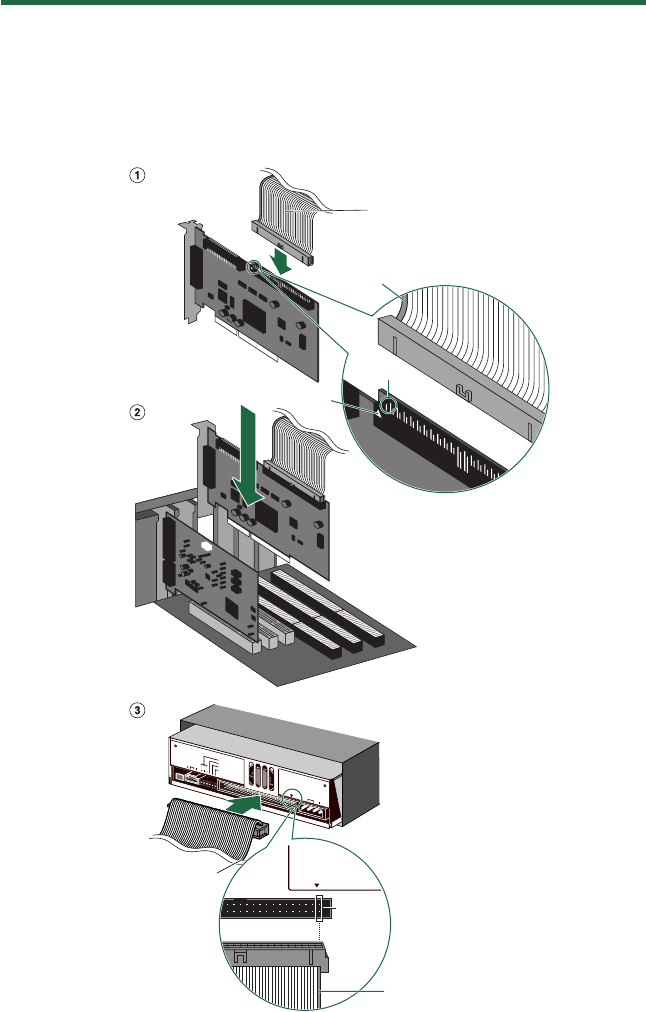
7Connect one end of the 50-pin SCSI flat cable to the computer’s SCSI adapter card.
Align the red line of the cable with Pin 1 of the card’s SCSI connector. Then put the
SCSI adapter card back into its original slot in the computer. Next, connect a free
50-pin connector on the SCSI flat cable to the back of the CRW6416S drive such
that the red line on the cable is aligned with Pin 1, marked “SCSI INTERFACE
CONNECTOR 1.”
AUDIO OUT
ID SELECT
PARITY
TERMINATOR
BLOCK SIZE
SCSI
INTERFACE
CONNECTOR DC INPUT
1+5V G +12V
R L 1 2 4G
SCSI adapter card
SCSI
INTERFACE
CONNECTOR
1
50-pin SCSI flat cable
Align red line
with Pin 1 of
SCSI INTERFACE
CONNECTOR
To Pin 1
Pin 1
Pin 1
Mark
Align red line with
Pin 1 of SCSI INTERFACE
CONNECTOR
23
Installation
2/19CRW/e.qx 2/19/99 5:46 PM Page 23
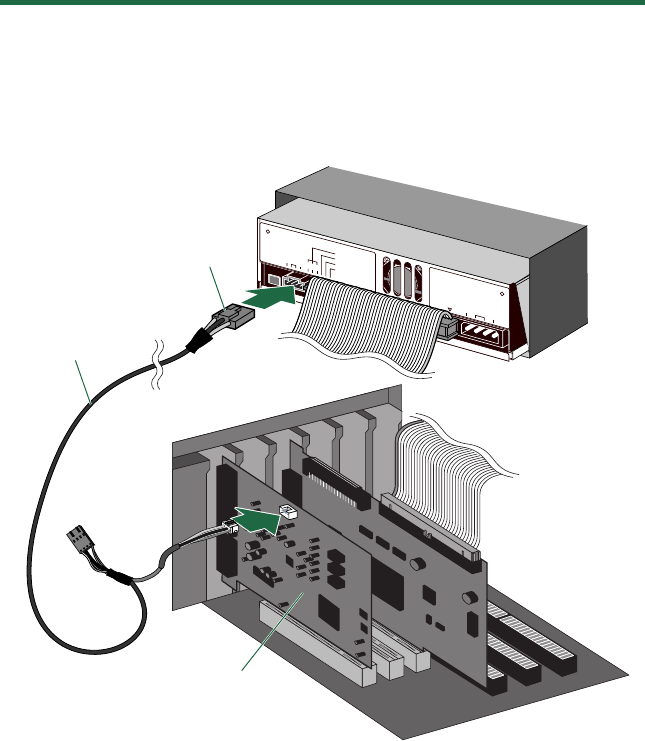
8Connect the audio cable between the CRW6416S drive and the computer’s
sound card, or the motherboard’s audio connector if it has built-in audio.
One end of the audio cable has two connectors: a smaller type and a larger
type. Choose one that matches your sound card’s connector. The connector
at other end of the cable is connected to “AUDIO OUT” of the CRW6416S
drive. Make sure connector’s lug is at the top.
nYou do not need to connect the audio cable to write audio CDs since the audio is passed over
the SCSI bus. It is required for playing back audio CDs on the CRW6416S drive via the
computer’s sound card. However, if a CD-ROM drive is already connected to the sound card,
you should use this drive to play back your audio CDs. To listen to audio CDs without a
computer sound card, connect headphones or speakers to the headphone jack on the
CRW6416S drive’s front panel.
AUDIO OUT
ID SELECT
PARITY
TERMINATOR
BLOCK SIZE
SCSI
INTERFACE
CONNECTOR DC INPUT
1+5V G +12V
R L 1 2 4G
Sound card
Audio cable
Lug
24
Installation
2/19CRW/e.qx 2/19/99 5:46 PM Page 24
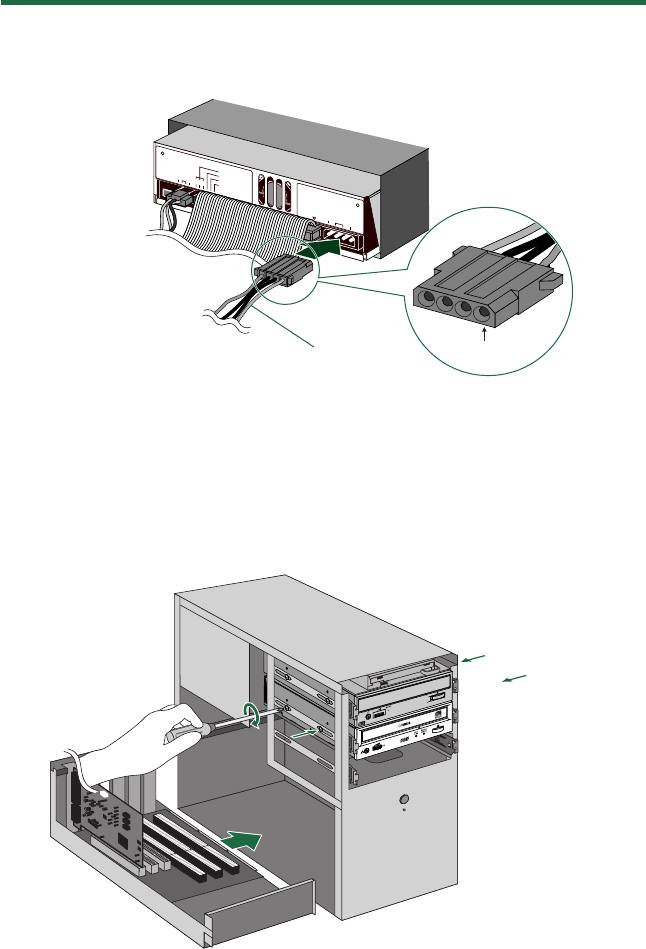
9Connect a 4-pin power cable to the power supply connector of the
CRW6416S marked “DC INPUT.”
nThere may be more than one 4-pin power cable available. Any may be used.
nThese connectors are D-shaped so it is only possible to connect the power cables the correct
way round. Do not apply excessive force when making this connection.
)Tighten the four fastening screws on the side of the unit securely using a
screwdriver.
AUDIO OUT
ID SELECT
PARITY
TERMINATOR
BLOCK SIZE
SCSI
INTERFACE
CONNECTOR DC INPUT
1+5V G +12V
R L 1 2 4G
TTopopTop
Bottom
4-pin power cable
25
Installation
2/19CRW/e.qx 2/19/99 5:46 PM Page 25
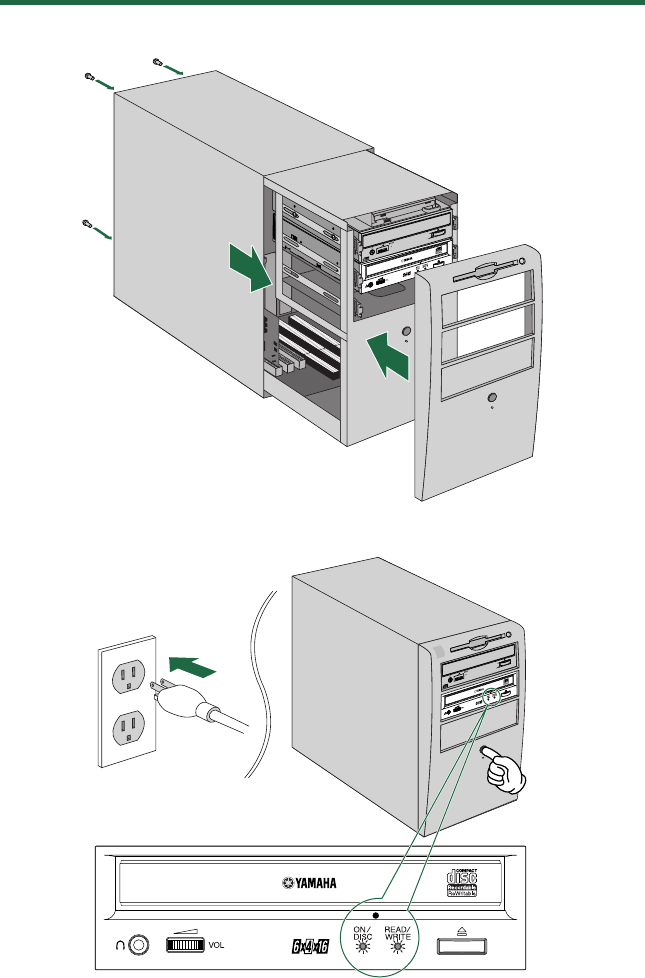
!Attach the outer casing of the computer and any screws that were removed.
@Reconnect the computer to the AC outlet and power it up.
nWhen you power up the computer, make sure both LEDs on the front panel of the CRW6416S
drive are lit.
26
Installation
2/19CRW/e.qx 2/19/99 5:46 PM Page 26
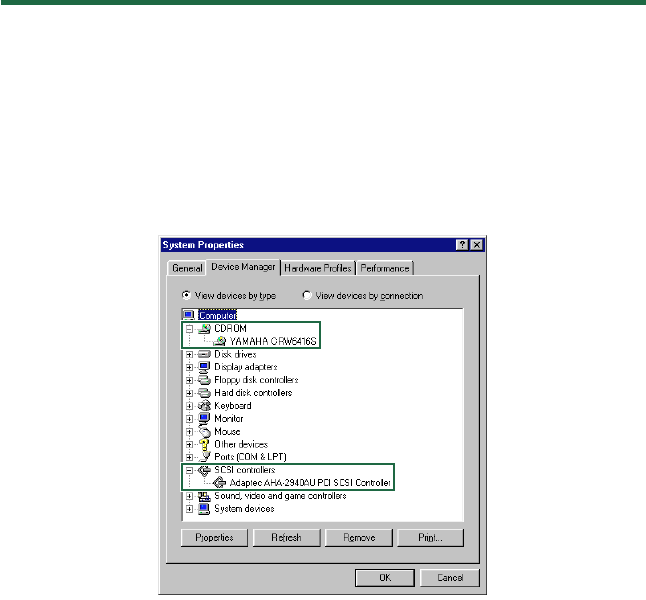
#After the computer’s operating system has loaded, open the Control Panel
and double-click on the System icon. Select the Device Manager tab and
double-click on CDROM. If the drive has been correctly installed, it should
be listed as shown below. Similarly, double-click on SCSI controllers and the
SCSI adapter card should be listed as shown below if it has been properly
installed.
nFor more information about how to use the operating system, refer to the documentation that
came with it.
$Install the CD writing software.
nRefer to the documentation that came the CD writing software for further details.
27
Installation
2/19CRW/e.qx 2/19/99 5:46 PM Page 27

Replacing an Existing CD-ROM Drive with the CRW6416S
nThe existing CD-ROM drive in the computer is assumed to be an IDE-type.
1Power down your computer and unplug it from the AC outlet.
If you proceed without doing this, you run the risk of receiving an
electric shock and/or short-circuiting and damaging components
including the CRW6416S drive.
2Remove the outer casing of the computer. If you need to remove screws in
the process, make sure you don’t lose them.
nThe method for removing the casing and fitting the drive in the drive bay can vary depending
on the manufacturer. Refer to the documentation that came with your computer for further
details.
28
Installation
2/19CRW/e.qx 2/19/99 5:46 PM Page 28
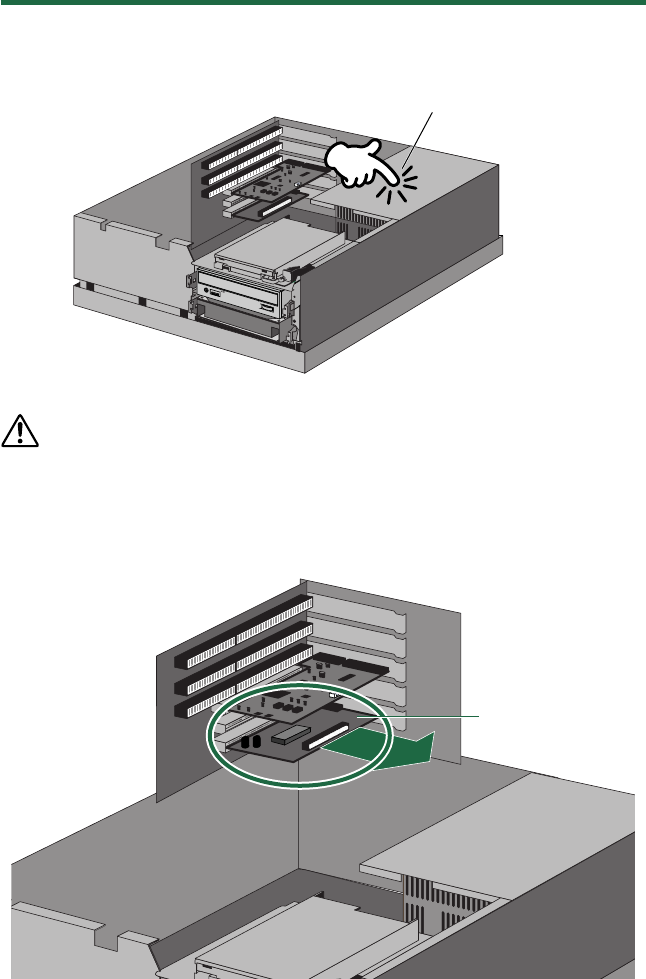
3Touch a metal part of the computer’s chassis or power supply unit to drain
any static charge that may have built up inside your body.
You can permanently damage equipment if you touch it while there is
any static charge in your body.
4Remove the SCSI adapter card from the computer and turn its termination
OFF so that internal SCSI devices may be connected. Refer to the
documentation that came with your SCSI adapter card for further details.
nSome SCSI adapter cards are capable of auto-termination. If your card is of this type, you will
not need to remove it from its slot since you will not need to set any of its switches or
jumpers.
SCSI adapter card
Drain any static charge
29
Installation
2/19CRW/e.qx 2/19/99 5:46 PM Page 29

5Disconnect all the cables connected to the rear of the existing CD-ROM
drive, and also disconnect the audio cable from the sound card or
motherboard’s audio connector.
6Remove the four screws holding the CD-ROM drive in place, then slide the
drive forward and out from the drive bay.
Slide the CRW6416S drive backwards into the now-vacant bay without
applying excessive force.
CRW6416S
CD-ROM drive
ANALOG
AUDIO
CABLE SELECT
SLAVE
MASTER POWER
HOST INTERFACE
1
2
39
40 +5V GG+12V
R LG G
Audio cable
IDE cable
4-pin power connector
30
Installation
2/19CRW/e.qx 2/19/99 5:46 PM Page 30
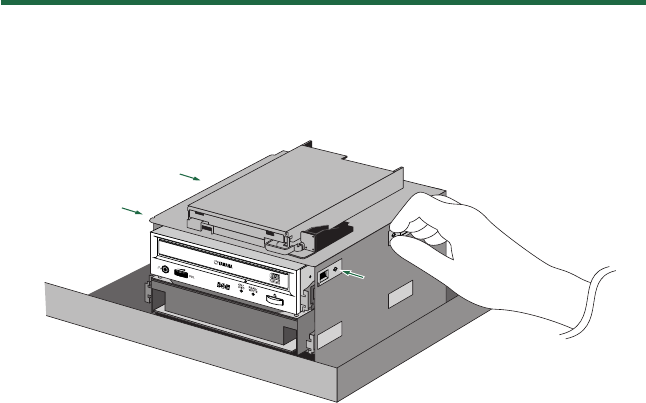
7Leave enough room behind the drive for connecting the power, SCSI and
audio cables. Then tighten the four fastening screws on the sides of the unit
by hand to hold the drive in place.
nThe four fastening screws are included with the drive.
31
Installation
2/19CRW/e.qx 2/19/99 5:46 PM Page 31
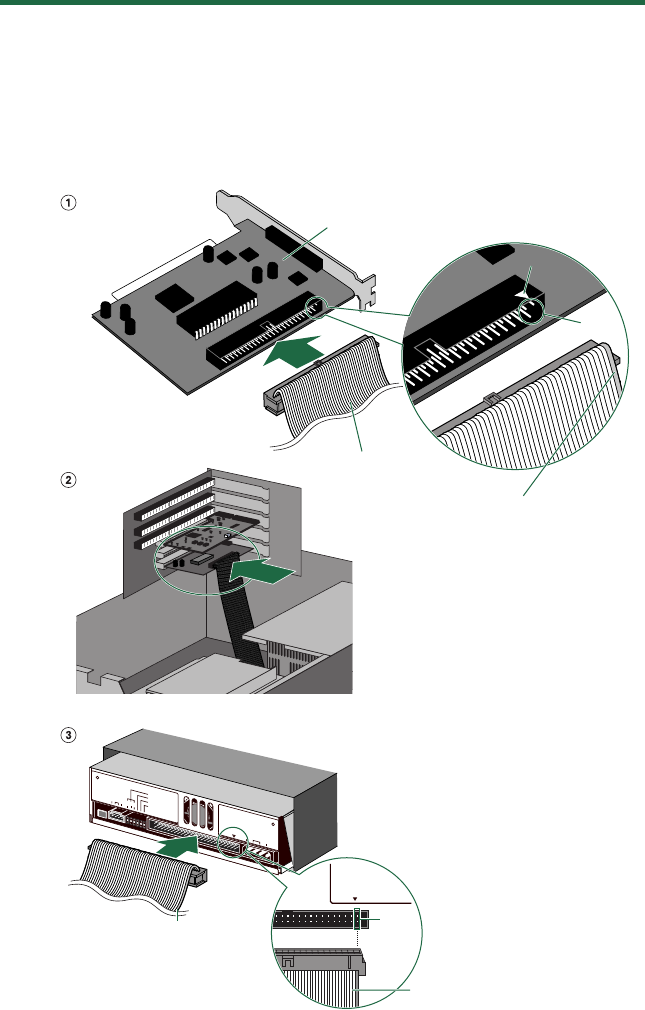
8Connect one end of the 50-pin SCSI flat cable to the computer’s SCSI adapter card.
Align the red line of the cable with Pin 1 of the card’s SCSI connector. Then put
the SCSI adapter card back into its original slot in the computer. Next, connect a
free 50-pin connector on the SCSI flat cable to the back of the CRW6416S drive
such that the red line on the cable is aligned with Pin 1, marked “SCSI
INTERFACE CONNECTOR 1.”
50-pin SCSI flat cable
AUDIO OUT
ID SELECT
PARITY
TERMINATOR
BLOCK SIZE
SCSI
INTERFACE
CONNECTOR DC INPUT
1+5V G +12V
R L 1 2 4G
Align red line
with Pin 1 of
SCSI INTERFACE
CONNECTOR
Pin 1
SCSI
INTERFACE
CONNECTOR
1
To Pin 1
SCSI adapter card
MarkMarkMark
Pin 1
Align red line
with Pin 1 of
SCSI INTERFACE
CONNECTOR
32
Installation
2/19CRW/e.qx 2/19/99 5:46 PM Page 32

9Connect the audio cable between the CRW6416S drive and the computer’s
sound card, or the motherboard’s audio connector if it has built-in audio.
One end of the audio cable has two connectors: a smaller type and a larger
type. Choose one that matches your sound card’s connector. The connector
at other end of the cable is connected to “AUDIO OUT” of the CRW6416S
drive. Make sure connector’s lug is at the top.
nYou do not need to connect the audio cable to write audio CDs since the audio is passed over
the SCSI bus. It is required for playing back audio CDs on the CRW6416S drive via the
computer’s sound card. However, if a CD-ROM drive is already connected to the sound card,
you should use this drive to play back your audio CDs. To listen to audio CDs without a
computer sound card, connect headphones or speakers to the headphone jack on the
CRW6416S drive’s front panel.
Sound card
AUDIO OUT
ID SELECT
PARITY
TERMINATOR
BLOCK SIZE
SCSI
INTERFACE
CONNECTOR DC INPUT
1+5V G +12V
R L 1 2 4G
33
Installation
2/19CRW/e.qx 2/19/99 5:46 PM Page 33
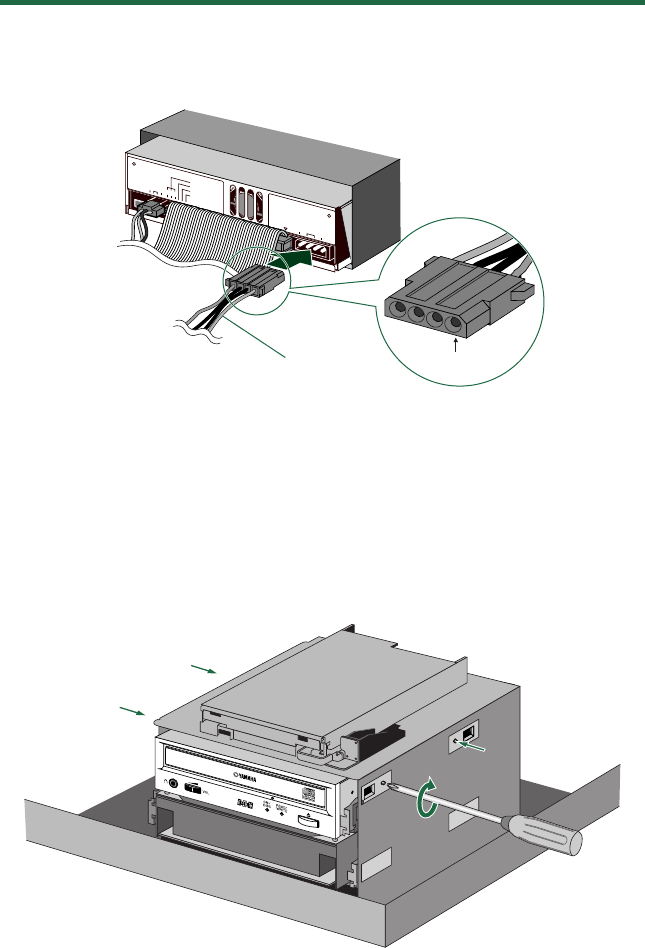
Installation
34
)Connect the 4-pin power cable to the power supply connector of the
CRW6416S marked “DC INPUT.”
nThere may be more than one 4-pin power cable available. Any may be used.
nThese connectors are D-shaped so it is only possible to connect the power cables the correct
way round. Do not apply excessive force when making this connection.
!Tighten the four fastening screws on the side of the unit securely using a
screwdriver.
AUDIO OUT
ID SELECT
PARITY
TERMINATOR
BLOCK SIZE
SCSI
INTERFACE
CONNECTOR DC INPUT
1+5V G +12V
R L 1 2 4G
TTopopTop
Bottom
4-pin power cable
2/19CRW/e.qx 2/19/99 5:46 PM Page 34
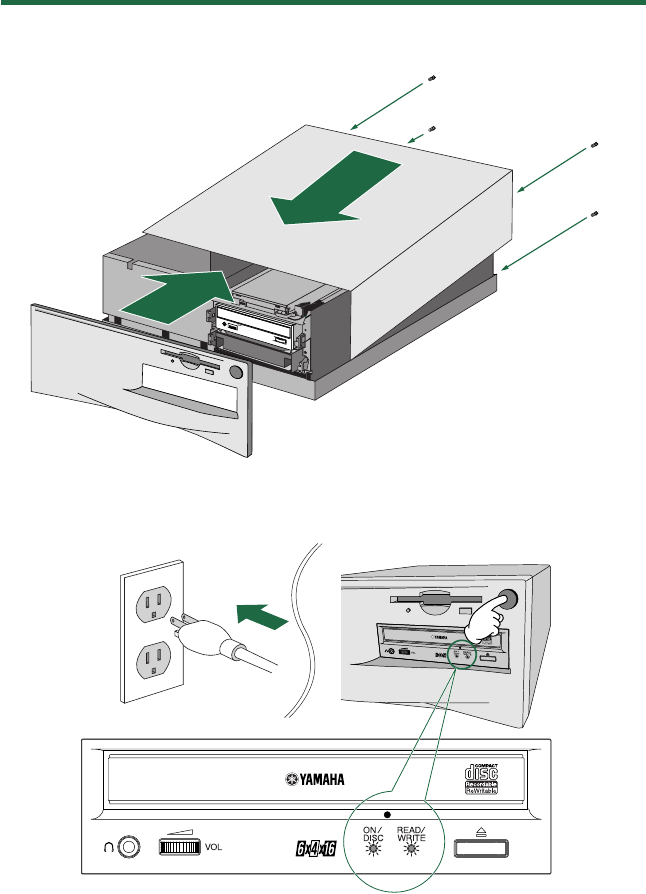
35
@Attach the outer casing of the computer and any screws that were removed.
#Reconnect the computer to the AC outlet and power it up.
nWhen you power up the computer, make sure both LEDs on the front panel of the CRW6416S
drive are lit.
Installation
2/19CRW/e.qx 2/19/99 5:46 PM Page 35
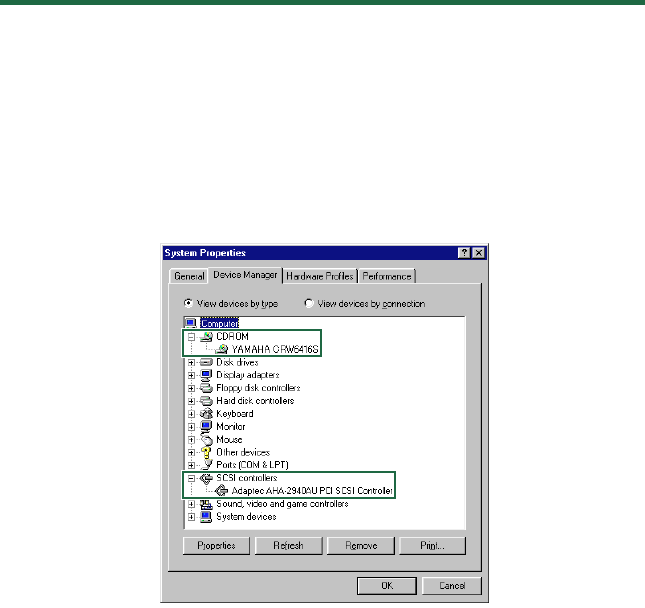
$After the computer’s operating system has loaded, open the Control Panel
and double-click on the System icon. Select the Device Manager tab and
double-click on CDROM. If the drive has been correctly installed, it should
be listed as shown below. Similarly, double-click on SCSI controllers and the
SCSI adapter card should be listed as shown below if it has been properly
installed.
nFor more information about how to use the operating system, refer to the documentation that
came with it.
%Install the CD writing software.
nRefer to the documentation that came the CD writing software for further details.
36
Installation
2/19CRW/e.qx 2/19/99 5:46 PM Page 36
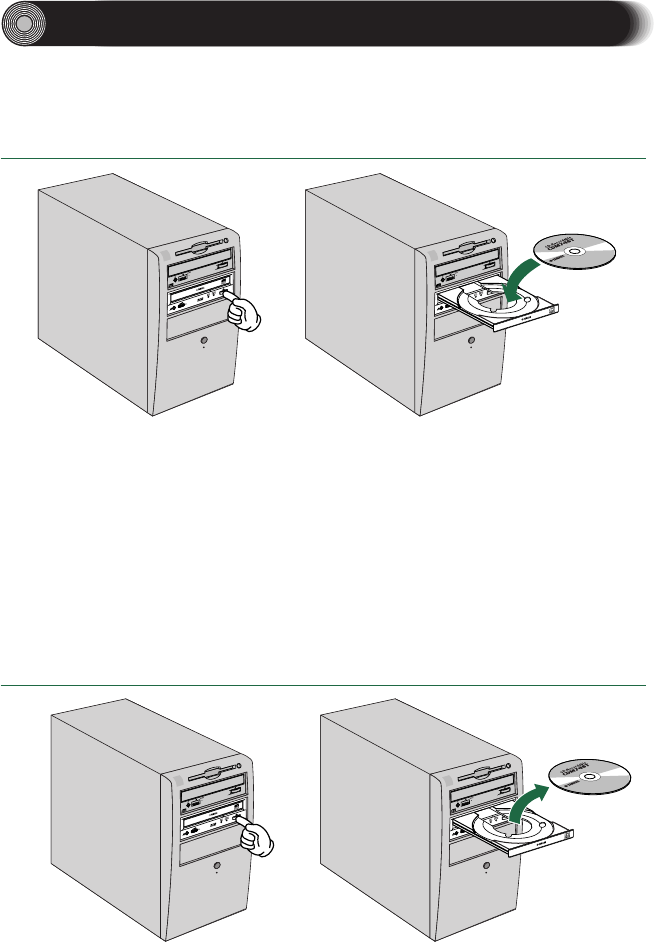
Operation
This section explains how to operate the CRW6416S drive after you have
installed it.
Loading a Disc
1Press the Eject button on the CRW6416S drive’s front panel.
2Place the disc onto the tray with its label or printing facing upward.
3Press the Eject button to close the tray.
nWhen a disc is loaded, the ON/DISC LED is lit up in orange first, then changes to green. For
more details, refer to page 44.
nDo not push or pull the tray using excessive force. Doing so can damage the drive or the disc.
Instead, always use the Eject button to open or close the tray.
Ejecting the Disc
1Press the Eject button on the CRW6416S drive’s front panel.
2Remove the disc from the tray.
3Press the Eject button to close the tray.
12
1 2
37
2/19CRW/e.qx 2/19/99 5:46 PM Page 37
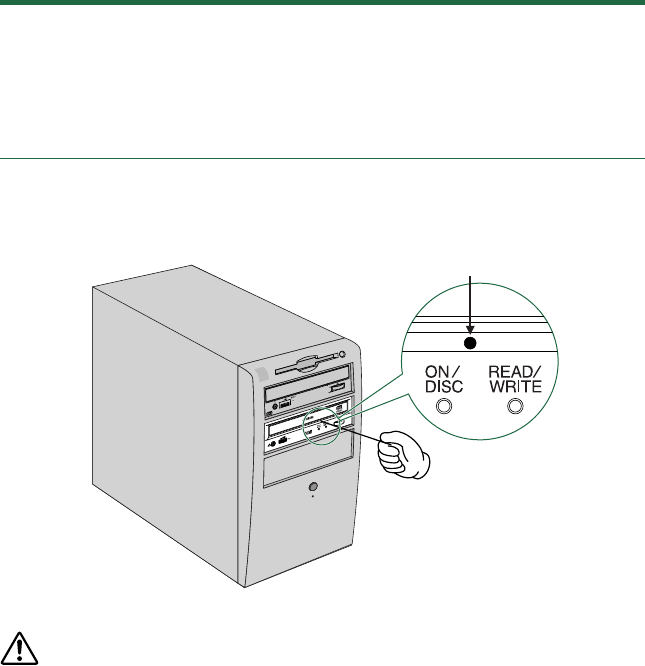
38
nThe disc tray will not open if the computer is not switched on. Also, depending on the SCSI
adapter card settings, it may not open if the drive is busy reading a disc.
nOnly remove the disc after the disc tray has opened fully. Otherwise, you risk damaging the
drive or the disc.
Manually Ejecting a Disc
If the disc tray fails to open for some reason, such as a power outage, the it can
be opened manually.
You should only attempt to eject a disc manually as a last resort.
Malfunctions may occur if you do this too frequently.
1Power down the computer.
2Find a pin-like tool with a diameter of 2mm or less to fit through the Manual
Eject hole on the drive’s front panel.
nA straightened paper clip is ideal for this purpose.
3Push the tool gently into the Manual Eject hole until the spring-loaded
mechanism ejects the tray and disc.
Manual Eject hole
Operation
2/19CRW/e.qx 2/19/99 5:46 PM Page 38
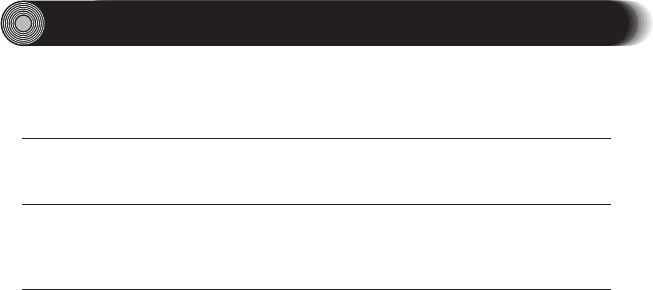
Troubleshooting
Please also refer to the Yamaha web site for more information.
Yamaha web site URL: http://www.yamaha.co.jp/english/product/computer/
The drive does not power up.
●Is the 4-pin power cable from the computer’s power supply attached correctly?
The computer does not start up.
●Is the SCSI card installed correctly? Please read the instructions that came with
your SCSI card for details.
The CRW6416S drive is not recognized.
●Is the 4-pin power cable from the computer’s power supply attached correctly,
and does the drive power up? Also, is the SCSI cable connected correctly?
If the system has started up normally, you will be able to see the CRW6416S drive
and SCSI card listed in Control Panel | System | Device Manager tab. The drive
will be listed when you double-click on CDROM and the SCSI card will be listed
when you double-click on SCSI controllers. (→P. 27, 36)
When you power up your computer, you can access the machine’s hardware BIOS
settings before Windows is loaded. You can set your computer to recognize the
SCSI card and CRW6416S drive in the BIOS.
n
The BIOS (Basic Input / Output System) is a small program that resides on a ROM chip on the
computer’s motherboard as well as on some expansion cards. It checks the system and its devices
(such as serial ports and hard disk controllers) before loading the operating system (OS).
●Are you using the correct SCSI driver?
If the SCSI card has not been installed correctly under Windows 95/98, make sure
that you have installed the most recent drivers supplied by the SCSI card
manufacturer.
If the SCSI card has not been installed correctly under Windows NT, update to
the most recent ASPI drivers supplied by the manufacturer of the SCSI card or
the CD-writing software.
For information about the latest version of any driver, please contact the
respective hardware/software manufacturers.
●Is the SCSI adapter card recognized correctly by the operating system (OS)?
The drivers for your SCSI adapter card may be incorrect. For more details,
contact the manufacturer of your SCSI adapter card.
●Is the drive’s SCSI ID number the same as that of another device on the SCSI
chain? (→P. 16)
●Are the pins and holes on the SCSI connectors straight and not deformed?
Check the connectors.
39
2/19CRW/e.qx 2/19/99 5:46 PM Page 39

40
●Is the terminator on the CRW6416S drive set correctly?
It should be set to ON only if it is the last device on the SCSI chain. Otherwise,
it should be set to OFF. (→P. 17)
●Is the termination on the SCSI card set such that internal SCSI devices can be
connected?
Please read the instructions that came with your SCSI card for details.
●To write to CD-R/RW discs, your CD writing software must support the
CRW6416S drive.
To find out if it does, contact the manufacturer of your CD writing software.
The disc tray does not come out.
●Is the CRW6416S drive powered up?
●Some CD writing applications will lock the disc tray once loaded.
In which case, use the eject command from within the application. Alternatively,
read the manual that came with the application.
The disc keeps being ejected.
●Has the disc been placed on the disc tray correctly?
The drive does not operate correctly.
●Is the disc compatible with the CRW6416S drive?
nEven if the disc is of a type compatible with the CRW6416S drive, some varieties of discs can
still be unreadable on it.
●Is there dust on the disc tray or on the disc itself?
●Is the terminator of the last device on the SCSI chain set to “on”? Or if it has no
built-in termination, has a terminator been attached?
●Does the computer have a sufficient power supply?
The CRW6416S has a power consumption of 11W (when reading and writing).
●Does your computer have several different CD writing applications installed?
If you use more than one CD writing application simultaneously, the behavior of
the drive can become unpredictable.
Troubleshooting
2/19CRW/e.qx 2/19/99 5:46 PM Page 40

41
The drive ejects or fails to read the disc, or the ON/DISC LED
continues to blink in orange after the disc has been loaded
(meaning that the disc has not been recognized).
●Disconnect the SCSI cable from the drive but leave the power cable connected,
then load a disc.
●You may be trying to write to an unusable disc. If the drive fails to write to a
variety of different discs, it may be faulty and you should contact your nearest
Yamaha dealer.
The “Buffer Underrun” error message is displayed.
●Try the following:
• Lower the writing speed setting (e.g., from 4x speed to 2x speed).
• Create an image file of the CD on the computer’s hard disk.
• Defragment the hard disk.
• Turn hard disk power management off.
• Deactivate the Active Desktop (if you are using Internet Explorer 4).
• Disable network access.
• Close other applications (including screen savers, task schedulers, etc.).
nErrors can occur if you knock the CRW6416S drive while it is writing to disc.
nWhen using packet writing on a CD-RW disc, the actual data capacity is 100MB less than that
stated on the cover of the disc. The difference in capacity is dependent on the writing mode.
Troubleshooting
2/19CRW/e.qx 2/19/99 5:46 PM Page 41
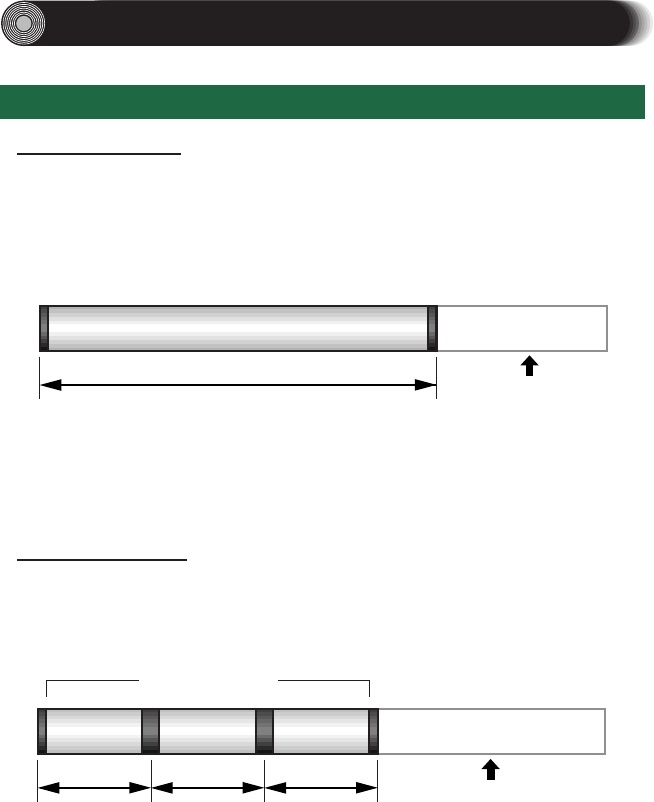
Appendix
Writing Modes
Disc-at-Once (DAO)
This mode is used when writing a complete disc in a single pass without
pausing. Data cannot be added later, even if the full capacity of the blank
disc has not been used. Although the data written from start to finish is
known as a “session,” no further sessions can be added later. This is why
Disc-at-Once mode is sometimes referred to as Single Session.
nThe lead-in and lead-out areas signify the beginning and end points of a session. They are not
part of the data but contain information about the session itself. Basically, a session consists of
a lead-in, data, and a lead-out. However, the maximum number of tracks (of either audio or
data) that can be written within a session is 99.
Track-at-Once (TAO)
This mode is used when writing data to a disc one track at a time. More
tracks can be added later if there is enough space left on the disc, provided
the total number of tracks does not exceed 99. This is why Track-at-Once
mode is sometimes referred to as Multisession.
nOnly the first session of a multisession disc can be played back on a conventional audio CD
player. Single session discs can be played back completely.
0
Up to 99 tracks
680MB
Track 1 Track 2 Track 3
Session 1 Session 2 Session 3 Any remaining space
can be used
Lead-in Lead-out
/Lead-in Lead-out
/Lead-in Lead-out
Track 1
Session 1 Any remaining space
cannot be used
0 Data
Lead-in Lead-out
680MB
42
2/19CRW/e.qx 2/19/99 5:46 PM Page 42
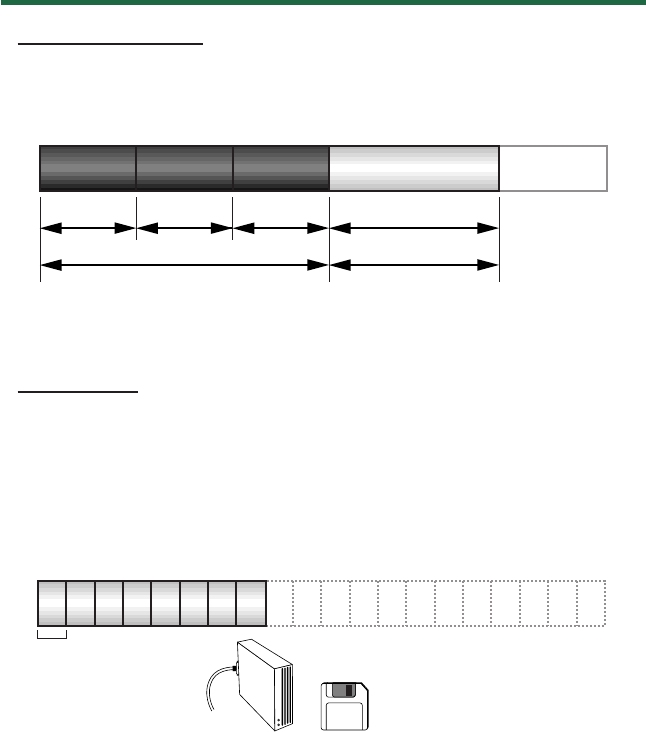
Session-at-Once (SAO)
This mode is used when writing each session in a single pass without pausing.
More sessions can be added later if there is enough space left on the disc.
nWith CD Extra, the audio is written in the first session and the data is written in the second.
A maximum of 99 tracks can be written.
Packet Writing
This mode is used when writing to a track of a disc using small blocks of
data called “packets,” in a manner similar to a floppy disk. This mode is
useful when making small incremental backups of data. You will need to
use software which specifically supports packet writing, such as Adaptec’s
DirectCD. The CRW6416S drive supports sequential (contiguous) and
random (non-contiguous) packet writing.
nDiscs must be formatted before they can be used for packet writing. With CD-RW, erased data
can be overwritten until the disc is completely full.
With CD-R, the space used by the erased data cannot be reused and is “masked” so that it is
no longer visible. This can be done up to 100 times.
12345678............
Packet
Same as writing to floppy or hard disk
Audio Audio Audio Data
Track 1 Track 2
(Session 1)
Track 3 Track 4
(Session 2)
Example (CD Extra)
43
Appendix
2/19CRW/e.qx 2/19/99 5:46 PM Page 43
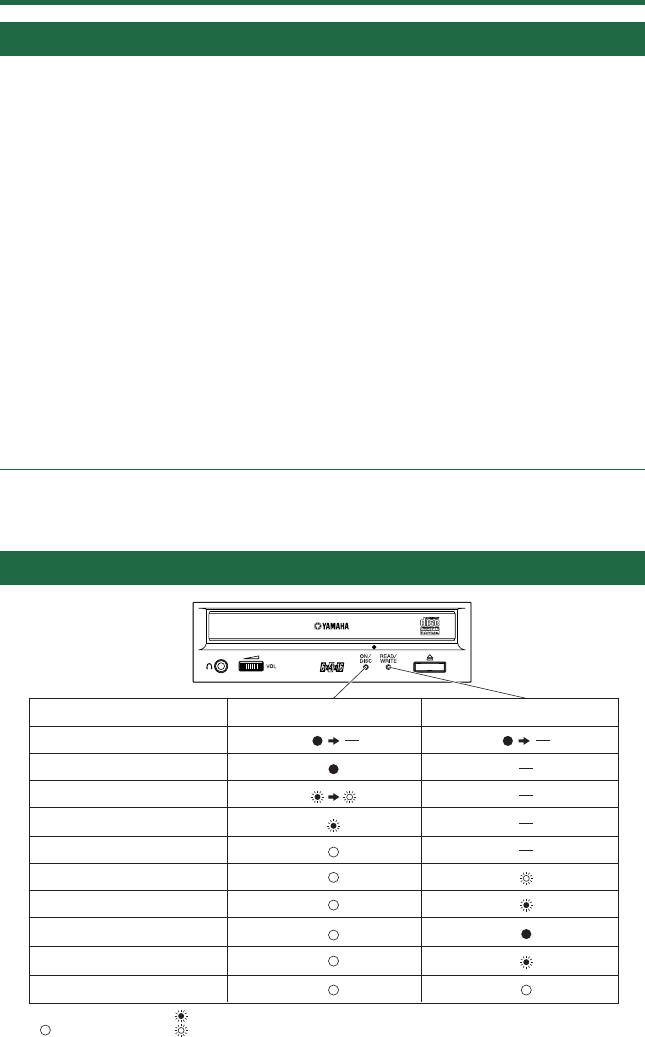
About the firmware
The
“
firmware” is a small piece of software built into the CRW6416S drive, and
is used to control its basic operation. Since it resides in flash memory, it can be
overwritten and updated.
To ensure the correct operation of the CRW6416S drive, updates to the firmware
will be made available. You can find information about the most recent firmware
for the drive on Yamaha’s web site.
URL for Yamaha’s web site
http://www.yamaha.co.jp/english/product/computer/
The most recent user support information, including firmware updates, can be
found in the CD-R area of Yamaha’s web site. Please check this information
regularly.
nThe firmware is completely unrelated to the CD writing application software.
Determining the firmware version of the CRW6416S drive
(in Windows 95/98)
Go to Control Panel | System | Device Manager tab, double-click on CDROM,
then double-click on Yamaha CRW6416S.
LED Indicator Messages
Status ON/DISC LED READ/WRITE LED
Power on (reset)
Ready (no disc)
Loading disc
Ejecting disc
Ready (disc loaded)
Seeking
Preparing to write
Writing
Writing (test mode)
Reading
● Lit: Orange Blinking: Orange —: Off
Lit: Green Blinking: Green
44
Appendix
2/19CRW/e.qx 2/19/99 5:46 PM Page 44
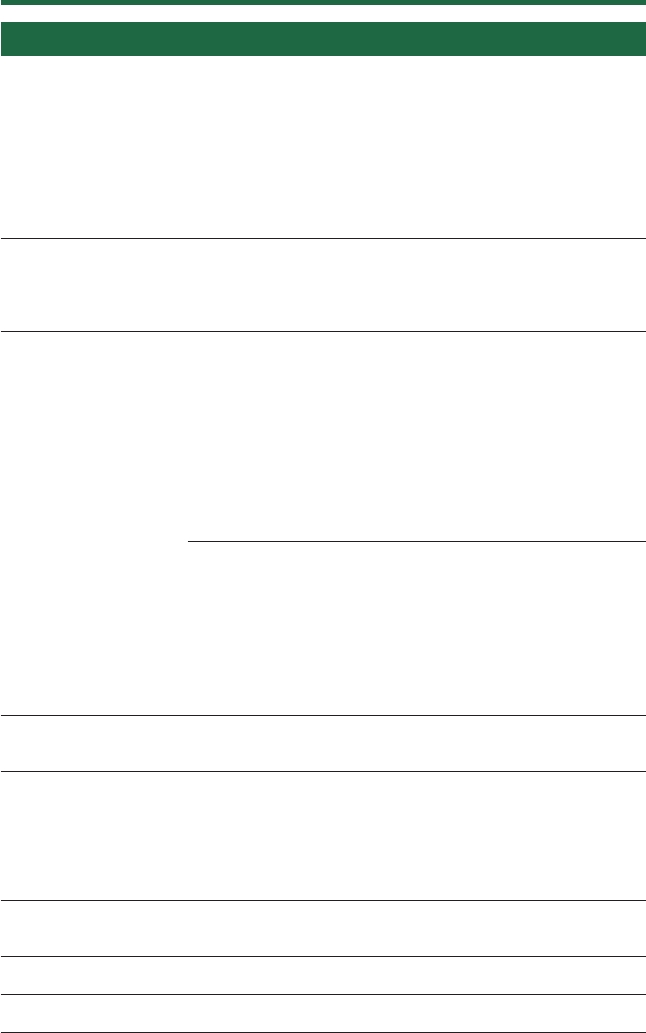
CRW6416S Specifications
Supported Write/Read Format CD-DA
CD-ROM
CD-ROM XA
CD-I
CD-Bridge
CD Extra
Video CD
Note) Excludes ADPCM Encode/Decode & Video
Encode/Decode functions.
Writing Methods Disc-at-Once (DAO)
Session-at-Once (SAO)
Track-at-Once (TAO)
Packet writing (variable, fixed)
Writing/Reading Speed Writing CD-R 1X, 4X, 6X
CD-RW 2X, 4X
Reading 9X-16X (max) Partial CAV
Note) • CD-DA extraction: 10X (max)
• Video CD: 6X (max)
• Drive can play CD-DA at 1X speed only.
• Finalized disc
CD-R: 16X (max) (10X max for packet writing)
CD-RW: 6X (max) (6X max for packet writing)
• Unfinalized disc: 6X (max)
CD-R 1X, 4X, 6X Writing: Orange Book Part II Ver.2.0-specified
WO disc
Note) When writing at 6X speed, use discs made for high
speed recording.
CD-RW 2X, 4X Writing/ReWiting: Orange Book Part III Version
2.0-specified RW discs
Note) When writing at 2X speed, Orange Book PartIII
Version 1.0-specified RW discs available.
Data Capacity 650MB (74 min.)
550MB (63 min.)
Data Transfer Rate 1X: 150 KB/sec
2X: 300 KB/sec
4X: 600 KB/sec
6X: 900 KB/sec
10X: 1500KB/sec
16X: 2400 KB/sec
Burst Transfer Rate 5 MB/sec (max) (asynchronous)
10 MB/sec (max) (synchronous)
Data Buffer Size 2 MB (666 sectors)
Average Random Access Time 180 msec (reading)
45
Appendix
2/19CRW/e.qx 2/19/99 5:46 PM Page 45
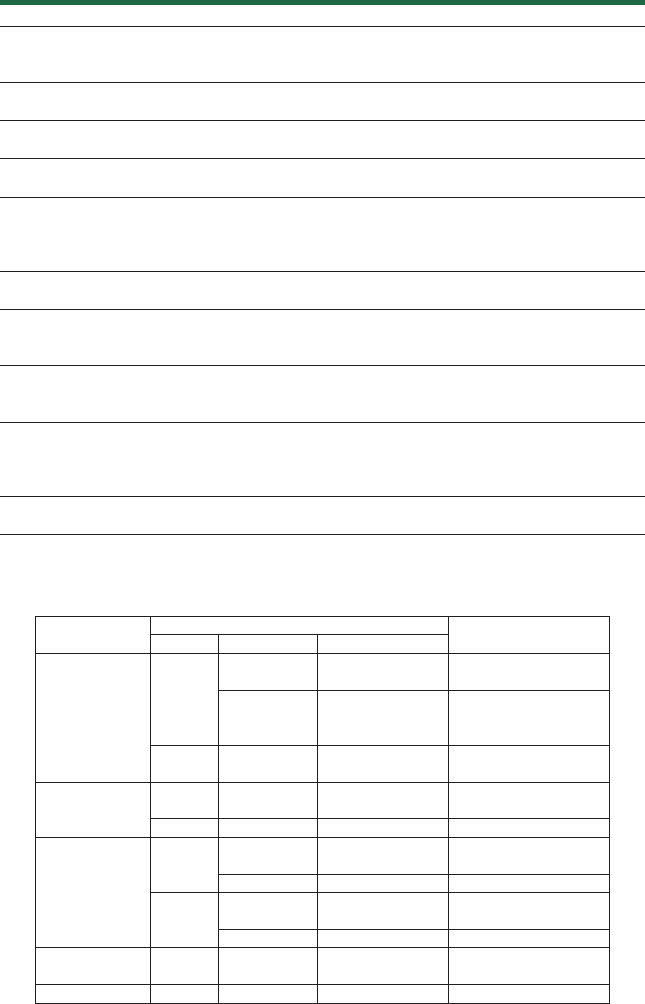
Appendix
Sector Size 2048 ~ 2352 B
512 B (read only)
Interface Fast SCSI-2
Installing style Horizontal
Disc Loading Type Tray loading
Audio Out Line Out
Frequency Range: 20 ~ 20,000Hz
Output Level: 1 Vrms
Power Consumption 11W (when writing or reading)
Power Supply 5V DC ±5%
12V DC ±10%
Operating Environment Temperature +5°C ~ +40°C
Humidity 25% ~ 80% RH (no condensation)
Dimension Width: 146.0 mm
Height: 41.3 mm (excludes 0.5 mm projection at bottom)
Depth: 193.1 mm (excludes front panel)
Weight 0.95 kg
Country / Region
USA
Canada
EU
Australia
New Zealand
Japan
Item
Electrical
Laser
Emission
Electrical
Emission
Electrical
Laser
Immunity
Emission
Emission
Emission
Standards
UL1950
21CFR1040.10
FDA Chapter 1,
Subchapter J
47CFR15
FCC Part 15, Subpart B
CSA C22.2 No. 950
ICES-003
EN60950
EN60825
EN50082-1
EN55022
AS/NZ 3548
VCCI
Details
Information Technology
Equipment
Class 1 Laser Product
Class B Computing Device
Information Technology
Equipment
Class B Computing Device
Information Technology
Equipment
Class 1 Laser Product
Residential, Commercial and
Light Industrial Areas
Class B Equipment
Class B Equipment
Class B Equipment
Category
Safety
EMC
Safety
EMC
Safety
EMC
EMC
EMC
The CRW6416S series complies with the following specifications.
Compliance Specifications
46
2/19CRW/e.qx 2/19/99 5:46 PM Page 46

Index
47
4-pin power cable..................................25, 34
A
Active Desktop ............................................41
additional drive............................................19
audio cable ............................................24, 33
AUDIO OUT................................................13
B
BIOS ............................................................39
block size ..............................................13, 18
Buffer Underrun ..........................................41
C
CD Extra......................................................10
CD-DA ........................................................10
CD-R discs ..................................................10
CD-RW discs................................................10
D
daisy chain ..................................................17
DC INPUT ..................................................13
Device Manager......................................27, 36
disc tray ......................................................12
Disc-at-Once (DAO) ....................................42
E
Eject button ................................................12
Ejecting the Disc ..........................................37
F
firmware ......................................................44
front panel ..................................................12
H
headphone jack............................................12
headphone volume control ..........................12
I
ID Select ................................................13, 16
IDE cable ....................................................30
J
jumper switches ..........................................15
L
lead-in..........................................................42
lead-out........................................................42
loading a disc ..............................................37
Long-Nosed Pliers........................................11
lug................................................................24
M
manual eject hole ..................................12, 38
manually ejecting a disc ..............................38
Multisession ................................................42
O
ON/DISC LED..............................................12
P
Packet Writing..............................................43
packet ..........................................................43
parity ....................................................13, 17
Phillips Screwdriver ....................................11
power connector..........................................30
R
random ........................................................43
read-only discs ............................................10
READ/WRITE LED ......................................12
rear panel ....................................................13
replacement drive ........................................19
S
SCSI adapter card......................21, 23, 29, 32
SCSI connector ............................................13
SCSI driver ..................................................39
SCSI flat cable........................................23, 32
SCSI ID number ..........................................16
sequential ....................................................43
serial number ..............................................14
Session-at-Once (SAO) ................................43
shunt............................................................15
Single Session ..............................................42
sound card ............................................24, 33
static charge ..........................................21, 29
T
termination ..................................................17
terminator..............................................13, 17
Track-at-Once (TAO)....................................42
V
Video CD ....................................................10
2/19CRW/e.qx 2/19/99 5:46 PM Page 47

Distributors and Head Offices
English: If you have any questions, please
contact your dealer or one of the following
companies.
French: Pour plus de détails sur les produits,
veuillez vous adresser à Yamaha ou au
distributeur le plus proche figurant dans la liste
suivante :
German: Bei weiteren Fragen wenden Sie sich
Sitte an Ihren Händler oder eine der folgenden
Firmen.
Spanish: Si tiene alguna pregunta, por favor
póngase en contacto con su distribuidor o una
de las siguientes empresas:
JAPAN
Yamaha Corporation
Electronic Systems Division
203 Matsunokijima, Toyooka-mura, Iwata-gun,
Shizuoka-ken, 438-0192 JAPAN
TEL: +81 539 62 3125
FAX: +81 539 62 5346
Internet: http://www.yamaha.co.jp/
U.S.A
Yamaha Systems Technology, Inc.
100 Century Center Court, San Jose, CA 95112
U.S.A
TEL: +1 408 467 2330
FAX: +1 408 437 8791
Internet: http://www.yamahayst.com/
CANADA
Yamaha Canada Music Ltd.
135 Milner Avenue, Scarborough,
Ontario M1S 3R1, CANADA
TEL: +1 416 298 1311
FAX: +1 416 292 0732
UNITED KINGDOM, BENELUX,
GREECE, CYPRUS, TURKEY and
EGYPT
Yamaha-Kemble Music (U.K.) Ltd.
Media Technology Division
Sherbourne Drive, Tilbrook, Milton Keynes
MK7 8BL ENGLAND
TEL: +44 1 908 366700
FAX: +44 1 908 368872
Internet: http://www.yamaha.co.uk/
GERMANY, SWITZERLAND,
AUSTRIA, EASTERN EUROPE and RUSSIA
Yamaha Europa GmbH
Multi Media Division
Siemensstrasse 22-34,
D-25462 Rellingen, GERMANY
TEL: +49 4101 303 200
FAX: +49 4101 303 277
Internet: http://www.yamaha-europe.com/
FRANCE
Yamaha Musique France S.A.
B.P. 70, 77312 Marne-la Vallée Cedex 2,
FRANCE
TEL: +33 1 6461 4060
FAX: +33 1 6461 4097
ITALY
Yamaha Musica Italia s.p.a.
Keyboard & Multimedia Division
Viale Italia 88, 20020, Lainate (Milano) ITALY
TEL: +39 2 935771
FAX: +39 2 9370956
Internet: http://www.yamaha.it/
SWEDEN and SCANDINAVIA
Yamaha Scandinavia AB
J A Wettergrens Gate 1, Box 300 53,
S-400 43 Gothenburg SWEDEN
TEL: +46 31 89 34 00
FAX: +46 31 45 96 07
Internet: http://www.yamaha.se/
SPAIN and PORTUGAL
Yamaha-Hanzen Electronica
Musical, S.A.
Jorge Juan, 30, 28001
Madrid, Spain
TEL: +34 91 577 7270
FAX: +34 91 576 6235
AUSTRALIA
Yamaha Music Australia
PTY., LTD.
17-33 Market Street,
South Melbourne,
Vic. 3205
Australia
TEL: +61 3 9693 5111
FAX: +61 3 9699 2332
SINGAPORE, MALAYSIA, INDIA,
INDONESIA and PHILIPPINES
Yamaha Systems Technology, Singapore Pte Ltd.
138 Cecil Street, #03-01A Cecil Court,
SINGAPORE 069538
TEL: +65 225 0050
FAX: +65 225 3669
Internet: http://www.yamaha.com.sg/
TAIWAN
Yamaha KHS Music Co., Ltd.
11F, No.150, Tun Hua North Rd.
Taipei ,Taiwan R.O.C.
TEL: +886 2 2713 8999
FAX: +886 2 2713 8666
Internet: http://www.yamahakhs.com/
2/19CRW/e.qx 2/19/99 5:46 PM Page 48
2/19CRW/e.qx 2/19/99 5:46 PM Page 49
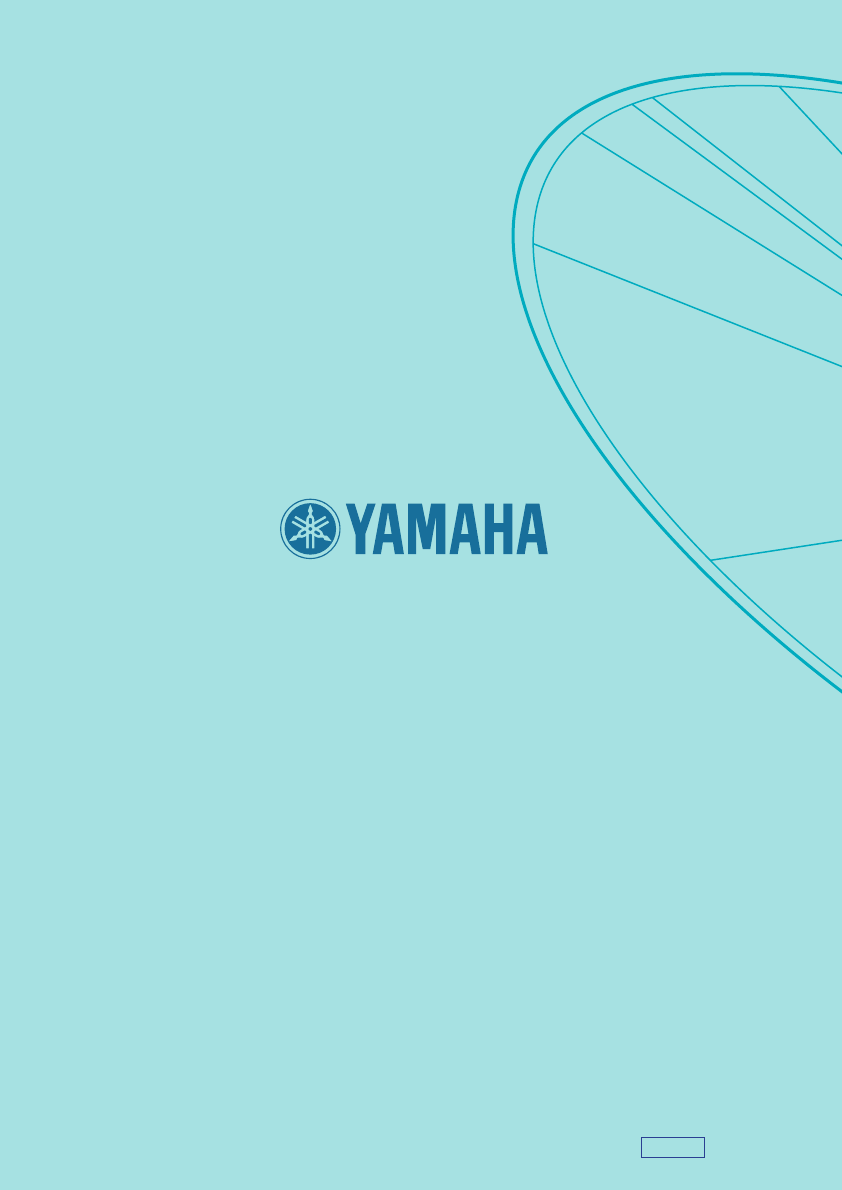
YAMAHA CORPORATION
Electronic Systems Divison
V365390 Printed in Japan
2/19CRW/e.qx 2/19/99 5:46 PM Page 50